Note
hey! how exactly do you start a studyblr? i just recently realized blogging abt it helps me study better and i was hoping you could give me some tips?? thank you :)
oh! basically i was going through my SAT bio study booklet, and my AP Psych booklet, and I realized that if I started trying to simplify my notes, and make them readable for people who didn't have the textbook, it would force me to understand the material.
I think my best tip is just to spend time making sure everything you post is readable/could be readable to anyone without any of the background information you have access to. It's a super good exercise and also makes your blog way more accessible
8 notes
·
View notes
Note
hi, what do u think the roles of clinical psychologists to exceptional learners?
assuming i am understanding what you're talking about, it depends on the "exceptional learner" - i will not lie, i am not a fan of that term or terms like special needs, special learner etc because it doesn't really get across what the student needs. a disabled student isn't an "exceptional learner" they're a disabled student.
i feel like there's both a lack of involvement from trained clinical therapists with disabled students that causes a lot of issues (whether students don't have access to them because they're too expensive, or the student goes undiagnosed) or too much involvement, especially from therapists using methods that aren't good for the student, or are actively harmful (cough, aba).
0 notes
Note
this blog basically saved my life on the AP Psychology exam! thank you so much!
aw np!
0 notes
Photo
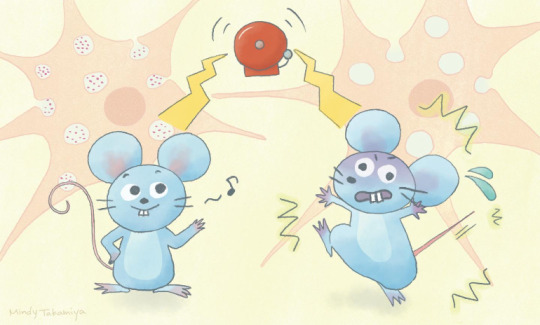
Large Transporter Protein Linked to Schizophrenia
Mutations of the ABCA13 cholesterol transport protein are associated with schizophrenia-like behaviors in mouse models.
37 notes
·
View notes
Photo

Lytic cycle vs lysogenic cycle of viruses…in a GIF!
917 notes
·
View notes
Photo
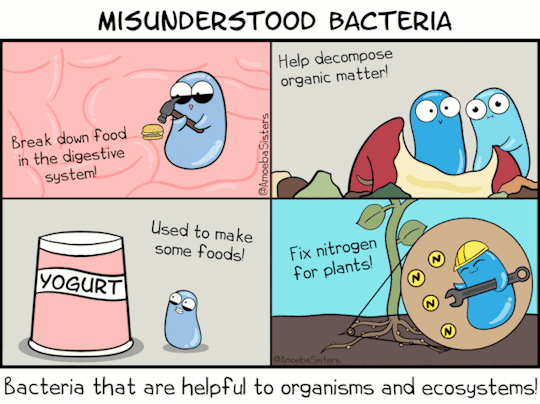
Some bacteria are just sOoOoOo misunderstood.
1K notes
·
View notes
Text
Testing and Individual Differences
Francis Golton was one of the first to study human intelligence and testing, and initiated the use of surveys to collect data, along with creating and applying statistics towards its analysis.
Standardisation and Norms
A test that is standardised is a test that has been piloted on a group of people similar to the population that is supposed to take the test, where achievement norms have been established. An easy one for many students planning on studying in the US is the SAT. At the end of the SAT, students take an extra set of questions that aren’t graded. These questions are developed so the Educational Testing Service can continue to standardise coming exams. Since the students taking the SAT are representative of the groups taking the SAT as a whole, they are known as the standardisation sample. People who make tests (known as psychometricians) at ETS use the achievement of students on the experimental section of the exam to decide how the next exam will be formulated. Questions nearly everyone gets right or wrong are discarded as they aren’t useful for differentiating between students.
Reliability and Validity
In order for a test to be taken seriously, it needs reliability and validity.
Reliability is the consistency of the test as a means of measurement. For instance, if you take an IQ test and score 99 the first time, 115 the next time, and 160 the third time, the test isn’t very reliable. There are many ways to measure a tests reliability. Split-half reliability involves randomly splitting a test into two different sections and correlating someone’s performance on the two halves. The closer the correlation coefficient is to +1, the greater the split-half reliability. Equivalent-form reliability is the correlation between someone’s performance on two different but equivalent forms of the same test. Finally, test-retest reliability is the correlation between 2 different administrations of the same test.
A test is valid if it measures what it’s supposed to measure. If Albert Einstein took an IQ test and got 99 all 3 times, you can say the test is reliable, but it’s clearly not very valid. A test cannot be valid if it is not reliable, however it can be reliable without being valid. There are multiple different kinds of validity, for example, face validity is a superficial measure of accuracy- it is the degree to which a test appears effective. If you’re looking for a chef, a cake baking test has high face validity. Face validity is considered a type of content validity- This is how well a measure reflects the entire range of material is is supposed to be testing. The cake baking test doesn’t have great content validity if the chef needs to cook things other than cake. There is also criterion-related validity- the extent to which a measure is related to an outcome. There are two kinds of criterion-related validity: Concurrent validity which measures how much of a characteristic a person has now, and predictive validity which is a measure of future performance. Finally, construct validity, which is a measure of whether a test measures a construct accurately.
Types of Tests
Two common types of tests are aptitude tests and achievement tests. Aptitude tests measure potential while achievement tests measure what someone has learnt. Making a test that exclusively measures one of these qualities is nearly impossible. For example, take a Math Aptitude test- you can have two people, each with equal potential to do well in the subject, but one of the test-takers has spent years studying math, while the other has barely done it at all- it’s obvious who will score better. On a Chemistry Achievement exam, you can have two students who studied an equal amount, however one may have a higher test-taking aptitude and score better than the other.
There are also speed and power tests. Speed tests consist of a large number of questions asked in a short amount of time- typically time that is insufficient to complete the problems, and power tests typically gauge the difficulty level of problems that someone can solve.
Finally, there are group and individual tests. Group tests are given to groups of people at one time and have little to no interaction between the examiner and test-takers. Individual tests involve more interaction with the examiner and study one person at a time.
Theories of Intelligence
Intelligence is another one of those words that get thrown around constantly but are surprisingly difficult to define. A medical doctor would look like an idiot when talking to a group of quantum physicists about string theory, but logically we would still call him intelligent. Many psychologists draw a distinction between fluid intelligence and crystallised intelligence. Fluid intelligence is our ability to solve abstract problems and learn new things while crystallised intelligence involves using the knowledge we accrue over time.
Charles Spearman- Charles Spearman argued that intelligence can be expressed as a single factor. He used factor analysis to conclude that underlying the many different specific abilities (s) that people regard as types of intelligence is actually a single factor that he named g.
Howard Gardner- Howard Gardner subscribed to the idea of multiple intelligences. What made his theory unique was that the intelligences that he named encompass a much larger range of human activities than most other psychologists. For example, he named linguistic, mathematical, and spatial intelligence which line up with what most psychologists use, however, added: musical, bodily-kinesthetic, intrapersonal, interpersonal, and naturalist intelligence.
Daniel Goleman: Daniel Goleman is one of the main proponents of EQ, or emotional intelligence. These are related to Gardner’s intrapersonal and interpersonal intelligence.
Robert Sternberg- Sternberg has offered a nontraditional definition of intelligence. His triarchic theory defines 3 types of intelligences. Componential or analytic intelligence describes our ability to compare, contrast, explain, and analyse. Experiential, or creative intelligence observes how people use their knowledge in innovative ways. Thirdly, is contextual or practical intelligence. These are people who are able to apply their knowledge to the real world. Sternberg’s theory also raises another question- does intelligence depend on context? Sternberg would say yes. Most intelligence tests however view intelligence as ability based rather than context based.
Intelligence Tests
There are two widely used individual tests- the Stanford Binet and Wechsler, however there are as many different types of intelligence tests as there are theories for what intelligence actually is.
Alfred Binet wanted to make a test to identify the children who needed extra help in school. His test was based on the idea of mental age, supposing that intelligence increases as someone ages. A normal 10 year old has the mental age of a 10 year old. Louis Terman, a professor at Stanford university used this system to measure IQ (intelligence quotient), and create the Stanford-Binet IQ test. A score on this test is formulated by dividing their mental age by their chronological age and multiplying by 100. The 10 year old would have an IQ of 100- (10/10 x 100). This test gets a bit weirder with adults. To rectify this, Terman assigned all adults an arbitrary age of 20.
David Wechsler took a bit of a different approach. There are 3 different Wechsler tests- there is the Wechsler adult intelligence scale (WAIS), the Wechsler intelligence scale for children (WISC), which is given to children from ages 6 to 16, and the Wechsler preschool and primary scale of intelligence (WPPSI). These tests yield an IQ score based on deviation IQ. The tests are standardised so that the mean is 100, and the standard deviation is 15. Scores are found based on how many standard deviations they fall away from the mean. Someone who scores at the 15.87th percentile falls one standard deviation below the mean, and would receive a score of 85. Someone who scores at the 97.72nd percentile scored 2 standard deviations above the mean and would get a 130. Wechsler’s tests also provides scores on a number of sub-scales along with a total IQ score. The WAIS has 11 sub-scales. 6 produce a verbal IQ score, 5 produce a performance IQ score.
Bias
The accusation that tests like the SAT are biased is not a new one. Researchers looking into the SAT say that although different races and sexes score differently on these tests, they have the same predictive validity for all groups. Other researchers argue that both the tests and college grades are significantly biased due to the advantages white middle and upper class students benefit from.
Nature Versus Nurture
Here we are, back again on this debate which seems to appear everywhere throughout Psychology. Research suggests that both genetics and environment contribute to molding intelligence. When discussing the effects of nature and nurture, researchers use the term heritability- this is a measure of how much of a trait’s variation is explained by genetic factors. Heritability of 0 implies that the environment is completely in control of differences in the trait, while 1 implies that genetics is totally responsible. So how heritable is intelligence? Answering this question is extremely difficult as effectively studying this question would require studying a controlled population, rather than an individual which would bring up serious ethical questions. There have been some interesting findings, however.
The Flynn Effect is a finding that suggests environmental factors like nutrition, education, and even entertainment like TV can play a role in intelligence
Monozygotic/identical twins score much more similarly on intelligence tests than dizygotic/fraternal twins, however, bias may play a role in this as monozygotic twins tend to be treated more similarly than dizygotic twins.
To avoid this bias, researchers look to monozygotic twins separated at birth. There have been strong correlations in intelligence, however, bias may still be present as the twins may be placed in similar environments.
Some people (including the bloke who made the SAT) point to racial differences to prove that intelligence is genetically based. Carl Brigham used his test to “prove” that white people were superior to people of colour, while ignoring factors like poverty and lack of education, and English fluency when scoring his exams.
#Psychologyy#AP Psychology#Human psychology#psychology studyblr#psychology study blog#psych study blog#psych studyblr#biology studyblr#biology study blog#bio studyblr#bio study blog#testing#IQ tests#SAT#ACT#iq#studyblr#study skills#study blog
49 notes
·
View notes
Note
Hey! I just wanted to say that i absolutely love your blog thanks for the information ❤️🌼
no problem!! thank you so much 💖🥰
2 notes
·
View notes
Text
Personality
Personality is a very commonly used term, however it’s very difficult to define- some psychologists argue that it is biological and thus innate while others argue it is the accumulation of your individual experiences. An example is the idea behind Type A and Type B personalities- Type A people tend to be high strung, competitive, and ambitious. Type B people tend to be more laid back.
Psychoanalytic Theory
Sigmund Freud believed that personality was set in early childhood, as children go through his proposed stages of development (oral, anal, phallic, latent, genital). During the phallic stage, as pleasure moves towards the genitals, young boys go through the Oedipus crisis, and young girls go through the Electra crisis when they feel competition towards their same sex parent, and attraction to their opposite sex parent. Freud believed that as boys and girls notice their physical differences, girls experience penis envy (I really hate Sigmund Freud), and boys experience castration anxiety, where they fear they will be castrated if they misbehave. To protect themselves against this, they use identification as a defence mechanism. Identification is when people emulate and attach themselves to an individual they believe threatens them- this leads to boys attaching to their fathers and detaching from their mothers. Fixation on one of the stages of development can cause certain personality quirks- for instance, fixation on the anal stage may lead to someone with an anal expulsive personality, describing someone messy and disorganised. It may also cause an anal retentive personality, where the person is neat and hyperorganised.
Freud believed most human behaviour comes from the unconscious. We spend a lot of mental energy keeping unacceptable thoughts in the unconscious mind. There is also the preconscious (containing everything we could potentially summon to conscious awareness) and the conscious (containing everything we are thinking of at a given moment). He also thought that the personality came from three parts:
The id, which exists from birth is in the unconscious and is made of instincts and psychic energy- he thought there were two kinds of instincts, Eros (life instincts) and Thanatos (death instincts). Libido drives life instincts. The id is controlled by the pleasure principle which is the desire for immediate gratification.
The ego follows the reality principle. It emerges around ages 2 or 3, and operates partly in the conscious mind, and partly in the unconscious mind. It negotiates the desires of the id and the limitations of the environment.
The superego is also partially in the unconscious mind and partially in the conscious mind. It emerges around age 5 and is the conscience. The ego often has to act as the mediator of the superego and the id.
The ego uses defence mechanisms to protect the conscious mind from threatening thoughts. Some of these include:
Repression- Blocking thoughts from conscious awareness
Denial- Not accepting the truth
Displacement- Redirecting feelings towards another person or object.
Projection- Believing that the feelings one has towards someone else are actually held by the other person and directed at oneself
Reaction Formation- Expressing the opposite of how one truly feels
Regression- Returning to an earlier, comforting behaviour
Rationalisation- Coming up with a beneficial result of an undesirable circumstance
Intellectualisation- Undertaking an academic, unemotional study of a topic
Sublimation- Channelling one’s frustration towards another goal (often viewed as one of the more healthy defence mechanisms)
It should go without saying that a lot of Freud’s views are criticised for being nearly, if not completely impossible to study and prove. His theories have very little predictive power, and is seen as overestimating the importance of early childhood and sex. Finally, a lot of Freud’s views are very objectionable, and likely were guided by misogyny. His ideas of penis envy, and that women have weaker superegos seem to be based more on bias than empirical evidence. Feminists like Karen Horney and Nancy Chorodow suggested that if women were jealous of men, it was because of the advantages men enjoyed in society, rather than a simple desire to have a penis. They suggested the idea of womb envy, where mean are jealous of women’s reproductive capabilities.
Psychodynamic Theories
Freud’s followers developed offshoots of his theories. These new approaches are referred to as psychodynamic or neo-Freudian approaches. Carl Jung proposed that the unconscious is made of 2 different parts: the personal unconscious, containing the painful memories and thoughts the person doesn’t want to confront, termed as complexes, and the collective unconscious which is passed down by species, explaining certain cultural similarities. The collective unconscious contains archetypes which are universal concepts we all share, such as the shadow which represents the evil side of personality, and the persona which is people’s creation of a public image. Alfred Adler focused less on the unconscious, and more on the conscious role of the ego. He believed people are motivated by the fear of failure (inferiority) and the desire to achieve (superiority).
Trait Theories
Trait theorists believe that personality can be described by specifying peoples main characteristics, which they view as stable and motivate people’s behaviour. Some trait theorists believe the same basic traits can describe all people’s personalities (this is a nomothetic approach). Hans Eysenck believed that by placing people on an introversion-extroversion scale and a stable-unstable scale that he could describe their personalities. Raymond Cattell developed the 16 PF (personality factor test). More modern psychologists like Paul Costa and Robert McCrae felt personality can be described using the big five personality traits; extraversion, agreeableness, conscientiousness, openness to new experiences, and emotional stability/neuroticism. In order to reduce the massive amounts of terms we use to describe people into 16 or 5 traits, factor analysis may be used. This is a statistical technique allowing researchers to use correlations between traits to see which cluster together as factors.
Other trait theorists (ideographic theorists) state that using the same set of terms to describe everyone is nonsensical. Instead, each person can be described using a unique set of traits. Gordon Allport believed that a full understanding of someone’s personality was impossible when disregarding their personal traits. Allport found that a small number of people are so intensely influenced by one trait that it informs nearly everything that they do. These traits are cardinal dispositions. There are two other types of dispositions: central dispositions and secondary dispositions. Central dispositions have a larger influence on personality than do secondary dispositions.
Biological Theories
One of the oldest personality theories was biological. Hippocrates believed that personality was determined by the level of the 4 humours - blood, yellow bile, black bile, and phlegm. Biological theorists view genes, chemicals, and body types as the primary influencer of personality. There is growing evidence that the human personality is partially shaped by genetics. However, little evidence exists supporting the heritability of specific personality traits. This varies based on the type of trait- height is more heritable than intelligence, for example. However, evidence suggests that temperament (someone’s emotional style and way of dealing with the world) is heavily influenced by genes. One example of another early biological theory was William Sheldon’s somatotype theory. This theory identified 3 body types- endomorphs (fat), mesomorphs (muscular), and ectomorphs (thin) and associated different traits for each of these body types. A lot of Sheldon’s research, however, only showed correlation.
Behaviourist Theories
Behaviourists like B.F Skinner have a very different view on personality. They believe that behaviour is what determines personality- the reinforcement contingencies that one is exposed to is what creates personality, so by changing someone’s environment, you can change their personality
Social-Cognitive Theories
These theories meld together behaviourists view of the importance of the environment, and cognitive psychologists focus on patterns of thought. Albert Bandura believed that personality is created by the interaction between a persons traits, their environment, and their behaviour. He based his model on the idea of triadic reciprocality (reciprocal determinism)- meaning that each of these 3 factors influence the others in a looplike fashion. He also posited that personality is effected by a sense of self-efficacy- people with high self-efficacy are confident in their ability to do things while people with low self-efficacy feel powerless. The level of self-efficacy determines people’s actions, and as a result, the outcome of those actions. George Kelly created the personal-construct theory- suggesting that people, as they attempt to understand the world develop their own individual systems of personal constructs. Thus, personality is based on how people see the world. This theory is based on a fundamental postulate that states that behaviour is influenced by cognitions. Finally, Julian Rotter created the concept of locus of control. People either have an internal or external locus of control. Someone with an internal locus of control feels responsible for what happens to them (”hard work leads to success”). Someone with an external locus of control believe that luck and outside forces determine their destinies (”what family you’re born into determines success”)
Humanistic Theories
Most of the previous models, such as behaviourism and psychoanalysis are deterministic- which is the belief that what happens is dictated by what happened in the past. Neither support the idea of free will- which is the ability of someone to choose their own destiny (you goh the chance ta change yer fate!) The humanistic perspective is sometimes referred to as the third force as it arose in opposition to the determinism of behaviourism and psychoanalysis. Humanistic personality theories view people as innately good and able to determine their own destinies as they exercise free will. They stress the importance of someone’s self-concept (a person’s global feeling about themselves) and self-esteem (a person’s evaluation of their own self worth)
Abraham Maslow and Carl Rogers are the two most influential humanistic psychologists. They both believed that people are motivated to self-actualise. Rogers created self-theory- the idea that although people are innately good, they need things like unconditional positive regard from their interactions with others in order to self-actualise.
Assessment Techniques
When assessing personality, reliability (consistency) and validity (accuracy) are extremely important. Depending on their theories, psychologists methods for studying personality may differ.
Psychoanalysts tend to use projective tests, where they ask people to interpret ambiguous stimuli. For example, the Rorschach inkblot test, (where someone describes an inkblot) or the thematic apperception test (where someone describes what’s happening in a picture). Psychoanalysts believe these tests are outlets to project unconscious thoughts. Many people view projective tests as unreliable. A more simple and widespread method of personality assessment is self-report inventories where people take questionnaires, providing information about themselves. These kinds of tests are referred to as objective personality tests, versus an interview which would be called a subjective personality test, due to the potential for evaluator bias. An example is the Minnesota multi phasic personality inventory (MMPI-2) which is the most widely used. These tests can be viewed as invalid, however, as people may not be honest when answering questions. Radical behaviourists reject both of these assessments, preferring instead to observe behaviour in order to determine personality.
People tend to be curious about what personality assessments say about them, however this curiousity tends to make them easier to deceive. People tend to see themselves in vague descriptions of personality- this phenomenon is named the Barnum effect (after P.T Barnum) and is abused by people like astrologers, psychics, and fortune tellers.
#personality#psychology#AP Psychology#Biology#AP Biology#human biology#human psychology#psychology studyblr#psychology study blog#psych studyblr#psych study blog#biology studyblr#biology study blog#bio studyblr#bio study blog
65 notes
·
View notes
Text
Developmental Psychology
Research Methods
Studies involving human development are either cross-sectional (studies observing patients at different changes to see how different variables change over time) or longitudinal (studies observing one person over. a long period of time to precisely measure the effect of development on a specific group)
Prenatal Influences on Development
Two examples of prenatal influences are genetics (whose effect should be obvious; the chromosomes you’re born with influence the development of certain traits.) The amount of influence chromosomes have on development over environment can be observed in twin studies where the subjects have an identical genome. Another example is teratogens. Teratogens are chemicals or agents which can be inhaled, ingested, or contracted in some way by the mother. One of the most common is alcohol which can cause fetal alcohol syndrome (FAS) caused by severe alcoholism during pregnancy. A less severe condition caused by moderate drinking is known as fetal alcohol effect. A natural example is the virus Zika which made the news a few years ago for its devastating effects on newborns whose mothers had contracted the illness.
Motor/Sensory Development
Reflexes
While in the past it was understood that babies were “blank slates” research has shown babies have a specific set of reflexes, or automatic responses to certain stimuli.
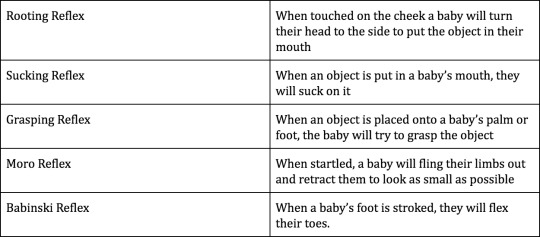
The Newborn’s Senses
Along with reflexes, humans are born with their sensory apparatus. Research has found that babies can hear before they are born, and have the same basic preferences in smell and taste that we do. The most different is sight. When we are born, hearing is the dominant sense due to baby’s poor vision (legally blind). Normally, by 12 months, sight becomes the dominant sense.
Motor Development
Assuming all goes according to plan, humans develop the same basic motor skills in the same sequence (commonly at different ages, however.) Our motor control develops when neurons in the brain connect with each other and become myelinated. Typically by 5 1/2 months, babies can roll over, stand at 8-9 months, and walk after 15 months.
Parenting
Attachment Theory
As important as nature is in development, nurture plays just as big a role in deciding how we develop. Biologist Konrad Lorenz found some infant animals imprint on individuals or even objects they see during a critical period after birth. While not so simple in humans or other complicated animals, attachment, or the relationship between child and caregiver has a profound impact on growth.
Harry Harlow- Harlow raised baby monkeys with two artificial mothers. One had a bottle for the baby to eat, and the other was wrapped in a soft blanket. The babies preferred the soft mother when scared despite not being where the food was. Without a real mother, the babies Harlow studied became stressed and frightened, giving insight into what the deprivation of attachment can do.
Mary Ainsworth- Ainsworth researched what happened when newborns were placed into a strange situation- the parents would leave them for a short while and return. There were 3 types of reactions.
Infants with secure attachments explored the environment with their parents, became distressed when they left, and went to them when they returned.
Infants with avoidant attachments resisted being held by the parents, preferring to explore. They didn’t seek comfort upon the parents return.
Infants with anxious/ambivalent attachments (resistant attachments) were ambivalent to the parents. They were extremely distressed when the parent left but resisted comfort when they came back.
Parenting Styles
There’s a lot of debate about the “right” way to raise your child. Psychologists have been looking into the scientific answer, and there doesn’t seem to be a conclusive right way, however psychological research can point parents in the right direction. Psychologist Diana Baumrind researched parenting styles and defined 3 main categories of styles.
Authoritarian parents: set strict standards for their children and provide harsh punishments. Obedience is more important than rationalisation- “Why am I in trouble?” “Because I said so.”
Permissive parents: set unclear guidelines- rules either don’t exist or often change. Punishments may not be followed through on, and rule-breaking goes ignored.
Authoritative parents: have set, consistent standards for their children that they explain thoroughly to their child. If a child breaks a rule, it often includes a discussion about why the rule was important and why they are being punished.
Authoritative parenting has shown to produce the most desirable home environment. Children in these kinds of homes are often more socially capable and perform much better academically
Stage Theories
Nature vs Nurture is certainly important, but there’s another important debate going on in psychology; continuity versus discontinuity. Do we develop continually or do we have periods of rapid development and periods with little change? Biologically, we develop discontinuously, but what about thought? Lev Vygotsky’s concept of the zone of proximal development is one answer to this question. The zone of proximal development is the range of tasks a child is able to complete on their own. Adults can provide scaffolds to help them reach the upper end of their range encouraging further development. Stage theories are discontinuous theories by their nature. Two; Erikson’s and Freud’s are studied not because of their scientific merit but for historical reasons.
Sigmund Freud
Freud proposed we go through 5 psychosexual theories (sexual being where we derive our pleasure as we grow up.) If we fail to resolve conflict in any stage, we may become fixated- (preoccupied with behaviours associated with that stage.)
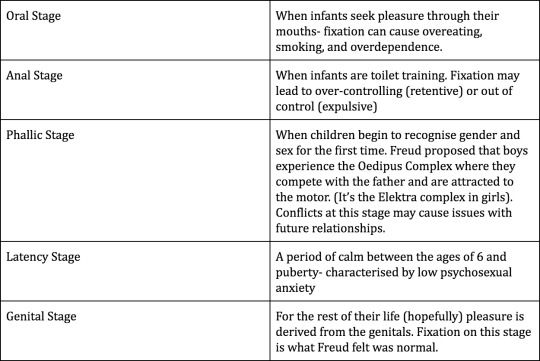
Erik Erikson
Erikson was a neo-Freudian- he believed in the basics of Freud’s theory but adapted it. He felt our personality was most influenced by our experiences with other, so created the psychosocial stage theory.
Trust versus mistrust: Babies learn whether they can trust the world to provide for their needs
Autonomy versus shame and doubt: Toddlers begin to exert their will over their own body. Here, toddlers learn how to control themselves and their environment.
Initiative versus guilt: When children begin to question everything- if initiative is encouraged, children will be comfortable about being curious later on.
Industry versus inferiority: The beginning of formal education. This is where students learn to produce work that will be evaluated- children may develop what is known as an inferiority complex where they don’t feel competent that can carry on for the rest of their life.
Identity versus role confusion: At adolescence, the goal is to find what social identity we are most comfortable with. Failure to resolve this conflict may cause an identity crisis.
Intimacy versus isolation: Young adults need to try to figure out how to balance their life- how much time should go to themselves, to family, to friends and to a partner?
Generativity versus stagnation: This is where the famous midlife crisis tends to happen. Adults here question whether they are making the best life they want.
Integrity versus despair: At the end of their life, elders either look back on their life with fondness or regret.
Cognitive Development
Jean Piaget
Piaget worked for Alfred Binet, creator of the first intelligence test, and was curious about the behaviours of the children he was interviewing. He noticed that certain age groups made similar mistakes. Piaget used this information to explain how children view the world through schemata, (cognitive rules). We tend to incorporate new experience into existing schemata through assimilation. When information contradicts that schemata, it’s modified. A little girl who’s only ever seen girls wear skirts will have to adjust her schemata if she goes to a pride march and sees boys wearing skirts. Piaget described cognitive development in 4 stages.
Sensorimotor Stage (Birth to 2). Babies begin to explore the world through their senses. One of the challenges is developing object permanence- the understanding that an object exists when you can’t see it.
Pre-operational Stage (2 to 7). After developing object permanence, the child will begin to use language and can refer to the world using symbols. Children are egocentric during this stage and can’t understand other people’s perspectives.
Concrete operational (8 to 12). During this stage, children learn to think logically about complex relationships between different objects- children at this stage demonstrate knowledge of the concepts of conservation. The understanding that properties of objects don’t change when the shape does. These concepts are shown in the diagramme below.
Formal operational (12 to adulthood). Formal operational reasoning is abstract reasoning. It’s the ability to manipulate and study objects and ideas without physically seeing or holding them. An example of this type of reasoning is hypothesis testing- a child in this stage would be able to answer a question like “what would you do if you were born somewhere where language didn’t exist” despite not having a model to relate back to.
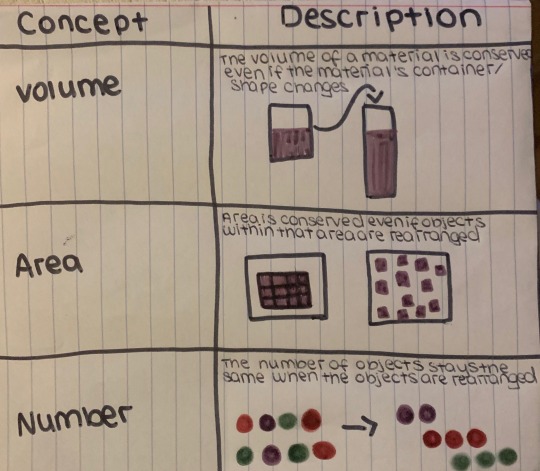
Criticism of Piaget: Information-Processing Model
Piaget’s model was imperfect- many children move through these stages at drastically different stages. His tests relied heavily on language which may have biased him towards the older children with a stronger grip on language. The information-processing model is a more continuous form of Piaget’s theory. It notes that our abilities to memorise, interpret, and perceive gradually develop as we grow up, instead of occurring at specific stages.
Moral Development
Lawrence Kohlberg
You can’t discuss moral development without discussing Kohlberg. His theory looked at how we reason about ethical situations and how that reasoning changes. His theory was built off of asking children a moral question (for example the Heinz dilemma- should Heinz steal medicine he can’t afford to save his wife’s life?)
Pre-conventional: People at this stage will make the best decision to avoid punishment. A pre-conventional answer to the Heinz dilemma is that he shouldn’t steal the medicine because he could go to jail.
Conventional: Moving past personal gain and loss, this stage focuses on how the choice a person makes will affect how others see them. A conventional answer to the Heinz dilemma is that Heinz should steal the drugs in order to be seen as a hero.
Post-conventional: People at this stage evaluate the rights and values involved with their decision. Self defined ethical principles can guide the decision someone makes (which can differ based on upbringing, culture, etc). A post-conventional answer to the Heinz dilemma is that he should steal the drug because his wife’s right to life outweighs the clerks right to property.
Criticisms of Kohlberg
Carol Gilligan was a notable critic of Kohlberg’s work, because in his research, he only looked at boys. When he did research girls, he tended to put their responses into lower categories, implying an intense amount of bias informing his work. Gilligan’s research showed that boys have a more absolute view on what is moral while girls are more attentive to situational factors.
Gender and Development
Biopsychological Theory
Biopsychologists concentrate on how nature influences gender. Children learn obvious differences between the sexes, however there are several more subtle ones. People assigned female at birth, for example have larger corpus callosums, theoretically affecting how the hemispheres coordinate and communicate.
Psychoanalytic Theory
Freud believed that gender identities begin to develop when children realise, unconsciously that they can’t compete with their same sex parent for the affections of the opposite sex parent (this theory is nearly impossible to study, which is why it has mostly been written off.)
Social Cognitive Theory
Social and cognitive psychologists prefer to observe how society and thoughts about gender can affect role development. Boys are more often encouraged to play rough, leading to more aggressive play. Gender-schema theory states that we internalise messages about gender to form cognitive rules about how different genders should behave. If all a child sees on the TV are girls wearing makeup and being interested in fashion, they’ll internalise the idea that women should be interested in makeup and fashion.
#developmental psychology#psychology#psych#AP Psych#Psychology study blog#Psychology studyblr#Psych study blog#Psych studyblr#biology#bio#biology study blog#biology studyblr#bio study blog#bio studyblr
84 notes
·
View notes
Text
Motivation and Emotion
Theories of Motivation
When Charles Darwin came up with his theory of evolution, many psychologists attempted to use it to explain all human behaviours through instincts that were weeded out through natural selection. There is still a debate about how much of our behaviour is decided through instinct, but it is agreed that many human behaviours are not.
Drive Reduction Theory
You’ll notice the creative naming of most of these theories. This theory is that our behaviour is controlled by physical needs. A drive is an impulse to act in such a way that satisfies an unfulfilled need to reduce that drive: you’re driven to eat a sandwich when you’re hungry. Every drive is your bodies attempt to maintain homeostasis or internal balance. When your brain determines that it doesn’t have enough glucose, that triggers a series of signals which eventually cause you to feel hungry to replenish glucose reserves. There are primary drives and secondary drives. A primary drive is a biological need, such as sex. A secondary drive is a learnt need like money.
Arousal Theory
Arousal theory states that we are constantly seeking an optimum level of arousal (not just sex. Get your mind out of the gutter.) Every person has a different optimum level of excitement someone with a high optimum level may be drawn to high thrill activities like rollercoasters or skydiving. That level also changes based on activity. We may do great at an easy task when extremely aroused, but not so well on a more difficult one. The relationship between arousal and performance is modelled by the Yerkes-Dodson curve.
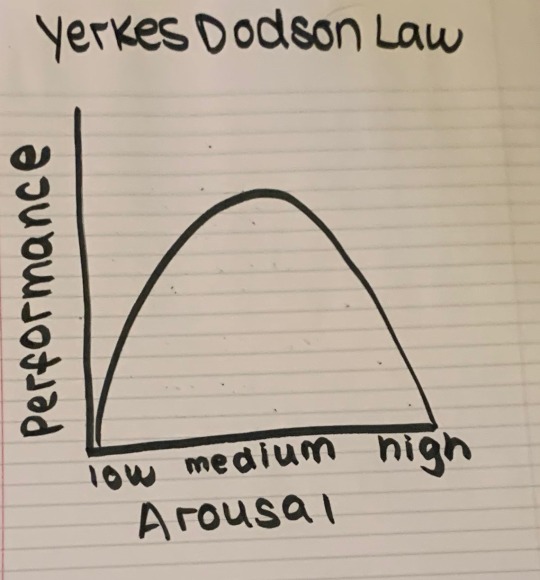
Another theory of motivation similar to arousal theory is the opponent-process theory of motivation (Yes, it’s the same name as the opponent-process theory of colour vision. Psychologists hate us and want us to do poorly on exams.) This theory tends to be used to explain addiction. People are usually at a baseline (normal) state. We may do things that move us away from that baseline state, such as having a pint. Initially, that action may be pleasurable, but eventually we feel an opponent-process, a motivation to return to our normal baseline state. An alcoholic may get sick of feeling drunk and want to quit drinking, but due to withdrawal it’s made extremely difficult, and moves us away from our natural baseline. That alcoholic may have a godawful hangover without alcohol, so he is motivated to return to the baseline state of feeling all right, motivating him to have more pints to feel normal again.
Incentive Theory
Incentives are stimuli we are drawn to due to learning- we learn to associate stimuli with rewards or punishment- for example, you could play Halo for 3 hours the night before an exam, but you learn to associate that with poor marks, motivating you to crack open a textbook and revise so that you get high marks.
Maslow’s Hierarchy of Needs
Humanist Abraham Maslow states that not all needs are equal. Our needs can be modelled as a pyramid, detailing which needs we want to satisfy before the others. To model, imagine a man trapped on a desert island with a few other survivors.
Physiological Needs: Needs like hunger, thirst, and sex. Say you arrived and you were extremely hungry. Before he can think about anything else, he’d likely start hunting down some food, and some water.
Safety Needs: The need to feel safe and out of danger. The island gets scary, especially at night, so the man constructs a hut that completely shelters him from the creatures that may roam the island.
Belongingness and Love Needs: The need to be accepted and belong somewhere. With the bottom two needs satisfied, the man may start trying to befriend the other survivors to try and form a community with them.
Esteem Needs: The need to gain approval and recognition. With his new community, the man may want to feel like he has a purpose with the new community- he may feel connected to his identity as the fisherman of the group that everyone recognises and appreciates.
Self Actualisation: With all of his other needs met, the man is now fully capable of fulfilling his unique potential.

While this theory explains a lot of human behaviour, there are many behaviours it doesn’t explain. Many poor parents go hungry in order to save enough money for their children to enjoy small luxuries. People are constantly putting their own lives at risk in order to save others; Malala Youzafi risked her life to speak out about women’s education in Pakistan.
Hunger Motivation
Some human behaviours can be deceptive in their complexity. Why do we get hungry? Because we need food- but that’s not always the case. For example, people tend to eat junk food like crisps while watching films despite not needing those crisps to feel full, and despite not feeling hungry at all.
Biological Basis of Hunger
There are several known biological cues which trigger hunger. By putting balloons into research subjects stomachs, and deflating and inflating them, researchers found that when the stomach is full we feel less hungry. The hypothalamus also plays an important role in hunger. By stimulating different animals brain, it was found that different parts of the hypothalamus are acting in opposition to controlling hunger. The lateral hypothalamus, also known as the hunger centre causes animals to eat when stimulated. The ventromedial hypothalamus, also known as the satiety centre causes animals to stop eating when stimulated. These two regions of the brain balance each other out.
The set-point theory is one theory that explains how the hypothalamus picks the correct impulse. The hypothalamus has an optimum body weight it wants to remain at. When our weight goes down, it lowers our metabolic rate (how quickly our body uses energy) and tells us to eat. When it goes up, it raises our metabolic rate and tells us to stop eating. Some researchers feel that psychological factors like learning and cognition are more important in weight maintenance. Along with that, the brain is analysing glucose and insulin levels to determine if food needs to be eaten.
Psychological Factors
Some reasons we get hungry have nothing to do with physiology. Some research has shown that some people (appropriately dubbed externals) are motivated to eat by external food cues and presentation of food and less motivated by internal food cues. An external food cue would be watching people eat Mcdonalds in an advertisement. An internal food cue would be feeling stressed and wanting to eat to feel better. Everyone responds to both to greater or lesser extents. The Garcia effect drastically affects what foods make us hungry. If you eat something and feel sick soon after, it makes it extremely difficult to stomach that food again. One time, when I was younger, I ate some ham, and soon after came down with the flu, and was puking my guts out. Logically, I knew that the ham had nothing to do with my sickness, but for a long time after I couldn’t even look at ham without flashing back to that sickness. Our culture also has a massive effect on what we find more appetising. I’m from England, so food that sounds appetising to me (beans on toast for example) may sound completely unappetising to readers not from there.
Eating Disorders
(Trigger Warning for discussions of different kinds of eating disorders. I’ll put a picture of my pet rat at the end of this section if you need to skip it. If you feel like you need help, please click this link for a list of hotlines with trained professionals on the other end of the line who can help you or someone you know through a crisis: https://www.bulimia.com/topics/eating-disorder-hotline/)
Another extreme example of hunger motivation not matching up with physiology is eating disorders. 3% of adolescents are diagnosed with one type of eating disorder, and disordered eating habits have become a massive problem in American culture. The three most common eating disorders are as follows:
Bulimia- Bulimia is characterised by periods of binging and then periods of purging (or non-purging in the case of non-purging types). Bulimics tend to eat massive amounts of food (although this is not always the case) and then purge it in any way they can, whether that be by throwing up, using laxatives, intense exercise, or fasting.
Anorexia-Anorexia is characterised by starvation. Anorexics tend to deal with a condition known as body dysmorphic disorder (although bulimics tend to suffer from it as well) where the brain obsesses over perceived “fat” even going so far as to having sufferers see themselves as larger than they are. Anorexics will starve themselves, or eat hardly anything for long periods of time.
Binge eating disorder- A harmful narrative surrounding eating disorders is the lack of conversation about the other end of the scale. Those suffering from BED tend to have recurring episodes where they eat massive quantities of food, often eating to the point of discomfort, and feeling a loss of control.
EDNOS/OSFED- (Eating Disorder Not Otherwise Specified or Other Specified Feeding or Eating Disorder). Not everyone suffers from the 3 main eating disorders. This diagnosis encompasses people who deal with disordered eating, but can’t quite be diagnosed into one of the 3. Some examples are purging disorder, night eating syndrome, and atypical anorexia nervosa.
The emphasis a culture places on weight tends to influence rates of eating disorders. It’s likely for this reason the US has some of the highest rates of documented eating disorders.

Sexual Motivation
Here’s the part of the discussion I’m sure you were waiting for once I mentioned arousal (you dirty-minded bastards.) Sex, like everything else has biological influences and psychological ones.
The Sexual Response Cycle
William Masters and Virginia Johnson were responsible for documenting the 4 steps in the sexual response cycle in adults (and I’m sure they had fun doing it.)
Initial Excitement: This is the point where blood rushes to the genitals. The clitoris will swell and the penis becomes erect. Heart rate and breathing rate also increase, and the skin may become flushed.
Plateau Phase: This is the point where genitals secrete fluids to prepare for sex. The heart rate and breathing rate also continue to rise.
Orgasm: Genitals begin to contract- heart and breathing rate continue to rise even further and men typically ejaculate. The release of neurotransmitters like endorphins and dopamine contribute to a sense of euphoria in both men and women.
Resolution Phase: Respiration and heart rate return to normal, and men enter a refractory period. Women, however, can enter back into the cycle immediately.
Psychological Factors
Hormones don’t strictly motivate sexual desires. One elusive aspect of sexuality is sexual orientation. Sexual orientation is an extremely (and unfortunately) controversial aspect of sexuality. Researchers like Alfred Kinsey (who developed the Kinsey scale which tracks the variety of human sexual behaviours) haven’t been able to push back against many of the rumours that exist about less “traditional” sexualities. There is little known about what causes sexual orientation, but no correlation has been found between trauma in childhood, parenting styles, relationship with parents, or masculinity and femininity and sexuality. Twin studies have found a genetic influence- one identical twin is likely to be gay if his twin is, and hormones in the womb may influence orientation.
Social Motivation
Humans aren’t robots. We experience more motivation outside of satisfying our needs for sex and food. Why are you reading this Tumblr post instead of reproducing, for example?
Achievement Motivation
One theory that attempts to explain more complex behaviours is a desire to master complex tasks and knowledge and to achieve personal goals. Research has found that people with high achievement motivation are consistently motivated to challenge themselves more than others, constantly setting the bar a little higher. This motivation varies between people and between activities. Clearly, I’m extremely motivated to do better in my classes since I’m sitting at my desk at midnight writing this- but I know how to cook 5 meals, and only 3 well because I have no motivation to do better at cooking.
Extrinsic/Intrinsic Motivation
Another way to think about social motivation is where the push is coming from. Extrinsic motivators are rewards we get for accomplishments outside of us (treats, high marks, salary etc). Intrinsic motivators are internal rewards like enjoyment or satisfaction. Are you reading this Tumblr blog because you want to get an A in your psychology class, or because you’re interested in psychology? Research into this form of social motivation tends to benefit managers and other leaders- studies show that advantageous behaviour we want to continue persists when influenced by intrinsic motivation. Extrinsic motivation tends to be more short-lived.
Management Theory
Studies looking into different management styles have found 2 main attitudes which affect how good managers are at their jobs.
Theory X: Managers believe employers will only work if rewarded for good work and punished for bad.
Theory Y: Managers believe employees are intrinsically motivated to do good work so policy should foster this motivation.
Theory Y has shown promise in promoting a better work environment and longer employee satisfaction.
When Motives Conflict
When discussing motivational conflict, psychologists tend to split them int 4 categories. Approach-approach conflict occurs when you have to pick between two good outcomes (Do I want to get ice cream or do I want to get brownies?) Avoidance-avoidance conflict occurs when you have to choose between to negative outcomes (Should I clear out the garage or deep clean the bathroom this Sunday?) An approach-avoidance conflict occurs when one event has both negative and positive features. (Even though I’m lactose intolerant, should I have some ice cream?) Finally, there’s multiple approach-avoidance conflicts. This is a situation where people are forced to pick one of multiple situations all with good and bad aspects about it. (Should I attend University A, B, or C?)
Emotion Theories
James-Lange Vs Cannon-Bard
One of the older theories of emotion came from psychologists William James and Carl Lange, who states that we feel emotion because of biological changes caused by stress. This theory was eventually challenged by Walter Cannon and Philip Bard who found that similar physiological changes occur due to drastically different emotional states- sometimes your heart races when you’re terrified or when you’re really excited. Cannon felt that the thalamus was both responsible for the biological change and the cognitive experience of emotion. When the thalamus receives signals informing us about our environment, it sends signals both to our cortex and the autonomic nervous system, making the physiological change and the conscious experience of emotion occur at the same time.
Two-Factor Theory
Stanley Schachter’s two-factor theory does a much better job of completely explaining emotion than both James-Lange and Cannon-Bard’s theories do. He thought that both our physical response and our cognitive label combine to form an emotional response. He found that people who are already stimulated will experience emotions more intensely than those who aren’t already stimulated.
Nonverbal Expressions of Emotion
Our nonverbal methods of communicating how we’re feeling have been found to be universal. Most every culture has the same basic facial expression to express happiness, sadness, anger, fear, etc. Research into sociobiology suggests that our facial expressions are actually a part of our genetics.
Stress
Stress and emotion are inherently linked. Psychologists tend to use stress to understand motivation and emotion along with help deal with problems caused by it. Stress can refer to life events (stressors) or our reaction to those stressors (stress reactions)
Measuring Stress
Thomas Holmes and Richard Rahe were the first to design an instrument that could measure stress. They used a social readjustment rating scale (SRRS) to measure stress using Life Change Units (LCUs). Someone taking this test would report a change in their life, such as having a new baby and each change would be assigned a different LCU. Different events were ascribed different LCU levels based on their intensity and their positivity- being married counts for more LCUs than being fired does. This method is not as widely used anymore as we now have more sophisticated ways to measure stress that include individual perception of events.
Selye’s General Adaptation Syndrome
Hans Selye’s general adaptation syndrome (GAS) is a description of the general response humans and animals have to a stressful event. His GAS Theory moves through the following stages:
Alarm Reaction: Heart rate increases, blood diverts from other parts of the body to the muscle, sympathetic nervous system is activated
Resistance: The body stays physiologically prepared. Hormones are released to ensure this preparedness lasts- spending too long in this stage can cause the body to exhaust itself.
Exhaustion: The parasympathetic nervous system is activated and returns our physiological state to normal. We are most vulnerable to disease in this stage especially after spending an abnormally long amount of time in the resistance stage.
Perceived Control
Studies have shown that a perceived lack of control contributes to stress. Rats who were given control over the duration of an electric shock were less likely to develop ulcers- patients given control over their morphine dosage tend to report better pain control. The feeling of a loss of control the COVID-19 outbreak has caused has massively contributed to the spike in mental health cases occurring as people are stuck in their homes.
#emotion#motivation#psychology#psych#psychology studyblr#psych studyblr#psychology study blog#psych study blog#bio#biology study blog#biology#biology studyblr#bio study blog#bio studyblr#AP Psych#AP Psychology#ap biology#tw:anorexia#tw: eating problems#tw: eating disorders#tw: bulimia#anorexia#bulimia#eating disorde#ednos#osfed#binge eating disorder#tw: binge eating disorder
34 notes
·
View notes
Text
Cognition
Models of Memory
Memory is an extremely difficult subject to study due to its subversive and subjective nature. Thus, many models have been proposed which describe how memories are processed by our brain. The two major ones are the three-box model and the levels of processing model.
Three-box model
This model of memory is also known as the information-processing model. It describes how the brain processes information (hence the name). Our sensory memory processes external events. Some of that information is encoded by the short-term/working memory. Some of that information is then encoded by the long-term memory.
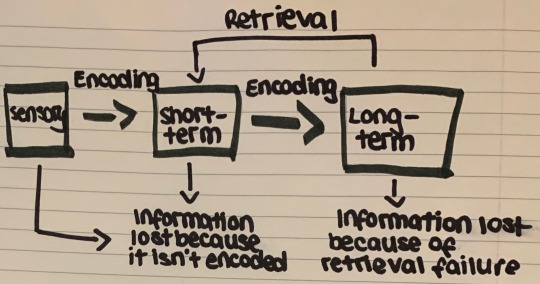
Sensory Memory: The sensory memory only lasts for a fraction of a second and consists of the information you are processing right now. George Sperling demonstrated this memory with his experiment, where he would flash a 9 letter grid to subjects for a split second. The subjects were then asked to recall either the top middle or bottom row letters immediately after they appeared. They were able to recite the letters, showing that that information was being stored for a short amount of time. This type of sensory memory is called iconic memory- a short lived photograph of a scene. There is also echoic memory, which is another short lived memory for sounds rather than pictures. Events that are encoded into the working memory are encoded as visual codes (a visual), acoustic codes (a collection of sounds), or semantic codes (the meaning of the event). In order to decide which memories are encoded into the working memory, the brain depends on selective attention. This means that information that is important to us is encoded. This is why we are able to ignore certain stimuli such as the sound of a fan, or the feeling of our clothes because they are not being encoded into the working memory. This is what makes the cocktail party effect work.
Short-term memory: Short-term memory is known as working memory because they’re the memories we’re working with in the present moment. They last longer than sensory memories, but not very long; usually around 10-30 seconds. Our short-term memory caps at around 7. In his experiments, George Miller found this number, and titled his research “The Magical Number 7, Plus or Minus Two.” So how do we improve the functionality of our short-term memory? One method is through chunking. Take psychology; there’s a lot of vocabulary to memories. If you try and memorise all of those words a couple nights before the exam, you’re not going to have much luck. Instead, it’s better to chunk that massive list into groups of 7. Another example of chunking is the famous mnemonic device; My Very Excellent Mother Just Served Us Nine Pizzas, where the names and order of the planets are chunked into the first letters of each word in the sentence. Another trick is to rehearse the information. Instead of staring at your vocabulary list, repeat the words you’ve chunked to yourself over and over again, thus maintaining that information in your short-term memory.
Long-term memory: These strategies are great for keeping information in our short-term memory, but the best strategies are ones that help encode that information into long-term memory, as it is our permanent storage. So far, it seems that long-term memories storage potential is unlimited. Once information makes it to our long-term memory, it stays- although it is subject to decay. It is stored in three different ways:
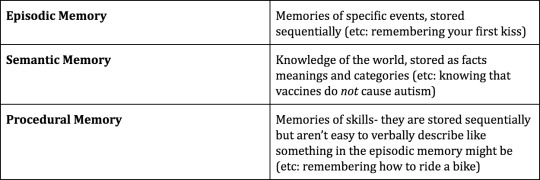
Memories can be explicit of implicit.
Explicit memories: Also known as declarative memories, these are usually what first come to our mind. They’re conscious memories that we actively try to remember. For example, at the moment, you’re trying to form explicit memories about psychology.
Implicit memories: Also known as non-declarative memories, these are memories we form unintentionally. You may realise when trying to cook lunch that you’ve managed to form an implicit memory on how to cook grandma’s famous pasta because you’ve watched her do it so many times.
An interesting phenomenon involves individuals with eidetic or photographic memory. Alexander Luria studied a patient who could repeat a list of 70 letters backwards, and could remember it as far as 15 years later.
Levels of Processing Model
Instead of describing memory in steps, this theory maintains that memories are either deeply/elaboratively processed or shallowly/maintenance processed. If to study for an upcoming psychology exam, you repeat a list of vocabulary words to yourself over and over again, you’ve shallowly processed that information, and will go away soon after you’ve taken your test. If you, however study those vocabulary words and do intensive research into each term, you’ve deeply processed those words, and will most likely be able to remember them long after your exam. The more cognitive energy you expend trying to remember something, the longer that memory will last. This model explains why we remember stories and questions better than boring old recitation of events and statements. We find the former more interesting, and more deeply process them.
Retrieval
All memory models end with retrieval. It is the process of taking information out of memory so it can be useful to us. Recognition is a process where we match a fact with one we already have stored in our memory. (”Where have I heard that song?”) Recall is retrieving a memory based on an external cue. (”What did grandma’s pasta taste like?”) There are all kinds of things that change why we’re able to retrieve some memories and why we lose others.
One factor was found by the early psychologist Hermann Ebbinghaus. He found that the order that things are presented in a list influence which things we remember. The primary effect states that we are more likely to remember the first few items on the list, while the recency effect states we are more likely to remember the last few items on that list. Both of these effects come together to form the serial position effect. The serial position effect indicates that we are the least likely to remember words in the middle of a list.
Another factor is context. Something that happens to all of us is the tip-of-the-tongue phenomenon. When I was taking my SAT Biology exam, I completely forgot the word “commensalism.” I sat there thinking facts that I knew about it; it’s a symbiotic relationship, it’s the relationship where one organism is helped and one isn’t hurt or helped” “I watched a youtube video about it” and although I remembered all these facts, it took me a second to remember the actual word. A theory that helps explain why this happens is the semantic network theory. This theory states that our brain forms new memories by joining their meaning and their context with those that already exist in our memory, forming an interlocking web full of memories. So when I was listing facts that I could remember about commensalism, I was making my way through the web, until I finally came across the word. Another phenomenon caused by context are flashbulb memories. When you ask someone who was conscious during 9/11, often they can give detailed descriptions of where they were and what they were doing. This is a flashbulb memory; where the importance causes us to encode more than we normally would.
The emotional context also affects retrieval. Mood-congruent memory is an interesting phenomenon, where you’re more likely to remember something when your mood matches the mood you were in at the time of the event. State-dependent memory is a similar phenomenon, where the state you’re in (for example, drowsy) allows you to retrieve memories from when you were in a similar state.
Constructive Memory
As much as we’d like to believe that it is, memory is not perfect. An example of this is the “recovered memory” phenomenon, where someone seems to “recover” a repressed memory that is actually a false memory based on outside influence. This phenomenon was discovered by Elizabeth Loftus. A constructed memory is a memory that contains false details of a real event, or a fake event altogether. This is why eyewitness accounts can prove to be problematic in police investigations. The way a policeman asks their question can completely change how the eyewitness remembers the event.
Forgetting
A number of things lead to forgetting. One example is decay where memories or connections that we don’t use a lot fade after a while. I used to be able to label every European country when I was younger, but now I’ll be lucky if I can get 15. These memories aren’t gone forever though; the relearning effect has shown that it takes less time recovering these memories than it took the first time. Another thing that causes forgetting is interference. There are two main types: retroactive interference and proactive interference. Retroactive interference is when learning something new hurts your ability to recall older information. Proactive interference is when something you learned a while ago interferes with your ability to learn newer information. A friend of mine told me a fun pneumonic that helps me remember the meaning of these two words: PORN- Proactive, Old interferes with new, Retroactive, New interferes with old.
How Memories are Stored
We know very little about the biological process of memory storage. Research performed on patients with brain damage has shown the hippocampus’ importance in encoding new memories. Patients with a damaged hippocampus had a condition known as anterograde amnesia, where new memories couldn’t form properly, but old memories could be recalled. Think of Dory from finding Nemo. Further connecting to Dory, remember how she could read but couldn’t remember that she could read? Researchers have found this phenomenon typical when studying anterograde amnesiacs, where they can learn and remember new skills but can’t remember learning that skill, showing that procedural memory is stored elsewhere in the brain. When studying memories, researchers tend to focus on long-term potentiation. As neurons fire more and more, their connections can strengthen, making the receiving neuron more sensitive to messages.
Language
Elements of Language
All languages are built with morphemes and phonemes. Phonemes are the smallest unit of sound in a language. non-English speakers and non-Americans tend to have trouble with the American R- a phoneme that is particularly difficult to recreate. On the flip side, Americans tend to have trouble recreating the Spanish R, while a native Spanish speaker would find that phoneme easy to make. Morphemes are the smallest unit of meaning in a language. Morphemes can be words like “but” and “the” letter like “a” or “I” and prefixes and suffixes like “pre-” and “an-.” Phonemes make up morphemes, and morphemes make up words. The words are organised in a particular order which is known as syntax. Different languages have different syntaxes which can be difficult for non-native speakers to wrap their head around. In english, the order that adjectives are used to describe a word is very particular, and while unconscious for us, is extremely tricky for learners. When describing a dress that you just bought, would you say “my velvet, dinner, new dress? Or would you say “my new velvet dinner dress?” At the same time, in french, the syntax of adjectives can be very frustrating for us to learn. For example, the sentence: Ma ancienne lycée means the high school I formerly attended, while the sentence Ma lycée ancienne means my antique high school.
Language Acquisition
Studies performed by developmental psychologists have shown that while babies who are learning different languages are developing, they move through the same basic stages. The first step of language acquisition is babbling, and occurs when the baby is typically around 4 months old. Babbling is innate, as shown by the fact that even deaf babies babble. Babbling is a babies way of experimenting with different phonemes, and at this point they can recreate all possible phonemes- this is why teaching a baby or very young child a new language can cause the accent to stick. As the baby continues to develop, the phonemes from its primary languages stick, and they lose the others. Babies will then move from babbling to single words (holophrases) which is aptly names the holophrastic/one-word stage, and normally occurs when the baby is one year old. The next milestone is telegraphic speech or the two-word stage. This typically is around 18 months. Toddlers will smash the words they know into basic commands; “No play!”- They have meaning down (”I don’t want to play right now!”), but are still working on grammar and syntax rules. As they learn these rules, they tend to misapply them. For example, a toddler may learn that “ed” indicates past tense, and may say “I runned to the store!” This is known as overgeneralisation or overregularisation.
The specifics of how we acquire language is a bit controversial. Behaviorists think that language is learnt through operant conditioning and shaping. If a baby makes a phoneme that exists in the parents language, or says a word, the parents will smile or pay more attention to the baby, reinforcing that behaviour. Cognitive psychologists challenge this idea. Noam Chomsky stated that humans are born with a language acquisition device. This is known as the nativist theory of language acquisition. He used children who had been deprived of language when they were young to show that there is a critical period for language learning. Today’s psychologists believe it is a combination of these two ideas.
Language and Cognition
How does language influence how we think? I know that personally, my personality changes when I am speaking French versus when I’m speaking English, and I know that I’m not alone. Benjamin Whorf theorised that the language we use affects and limits how we think. This is the linguistic relativity hypothesis. While studies have proven that language effects how we think about people, objects, and ideas, few have shown a drastic change in what we are able to think about.
Thinking and Creativity
Describing Thought
Describing thought is a monumental task; descriptions count as thoughts, so if I can get meta for a moment; we have to use thought to describe thought. It’s immensely difficult to create a global definition of thought, so psychologists tend to describe categories of thoughts instead. Concepts are similar to schemas. Everyone has cognitive rules we use to process our environments, and categorise objects, people, and ideas. We tend to base our concepts on prototypes, or what we think is most typical of a concept. Another kind of thought is an image, a mental picture we have in our mind of the world.
Problem Solving
There are two main kinds of problem solving, and like anything have their drawbacks and their advantages. Say you have a safe to open, and you don’t know the combination. There are two simple ways you can try and open it.
Algorithms: A simple, but arduous way to solve your safe problem is to try every single combination. This is an algorithm and is defined as a rule that guarantees the right solution by using a formula or other foolproof method.
Heuristics: If that safe combination is more than 2 numbers, you could be there all day just punching in numbers. Another thing you could try is using numbers that make up years you know are important to the owner of the safe. This is a heuristic. A heuristic isn’t foolproof and doesn’t guarantee a solution but can seriously shave down the time you spend solving your problem. There are severals of heuristics. Two of the main ones are representative heuristics and availability heuristics.
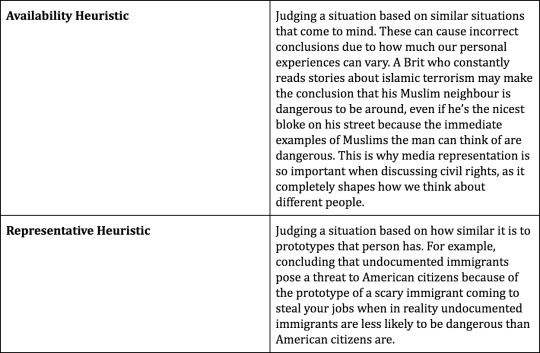
Heuristics can lead to overconfidence as we overestimate how good our judgements really are. This can lead to belief bias, and belief perseverance. Belief biases are illogical conclusions that we make to confirm preexisting beliefs. Belief perseverance is the tendency to maintain a belief even when evidence proves contradictory.
Impediments to problem solving:
Rigidity/mental set: The tendency to fall back into comfortable thought patterns. People tend to use problem solving methods that worked in the past to solve a new problem- this can cause people to ignore new solutions. A specific example of rigidity is functional fixedness which is the inability to see a new use for a specific object. Books are for reading, cups are for drinking, and clothes are for wearing. One time I accidentally spilled my tea on my desk, and instead of using the old shirt that was sitting next to my desk, I ran to grab a towel, allowing the tea to get everywhere and nearly ruin my computer.
Not breaking the problem into parts: Research has proven that by breaking a big problem down into smaller, manageable chunks, tackling the problem is significantly easier and tends to lead to success.
Confirmation bias: When we have made a conclusion about something, when researching it, we tend to ignore research that proves that conclusion wrong. This is why anti-vaxxers can spend hours scouring the internet and pull away one or two studies proving their point right, and completely ignore hundreds of articles that prove them wrong.
Framing: The way a problem is framed can completely impact our ability to solve that problem. If I were to give you a tricky math problem and tell you “99% of people have solved this problem,” you’d likely go into it not expecting much difficulty, while if I told you “99% of people can’t solve this problem,” you’d likely go in expecting something really difficult. This can completely change how able you are to solve a problem.
Creativity
How do you define creativity? Even harder: how do you find a global definition for creativity? While we may agree on some events exemplifying someone’s creativity, people’s individual criteria for creativity varies massively.
Some psychologists have delved into this problem. In his chimpanzee experiment, Wolfgang Kohler documented elements of insight by observing chimps get the banana from the ceiling. Research looking into creativity has found very little connection between creativity and intelligence. Research looking into creativity tends to look at convergent thinking; thinking pointed towards one solution, and divergent thinking; thinking pointed towards multiple possible solutions. Divergent thinking tends to be linked most closely with creativity.
#cognition#cognitive psychology#cognitive skills#study skills#studyblr#study blog#photographic memory#eidetic memory#psychology#psychology studyblr#psychology study blog#biology#biology studyblr#biology study blog#bi#bio studyblr#bio study blog#psych#psych studyblr#psych study blog#long term memory#short term memory#phonemes#morphemes#language#syntax#thought#thinking#philosophy
427 notes
·
View notes
Note
your blog is helping me a lot with my psychology degree, particularly with my psychobiology module. thank you!♡
Thank you so much! That means a lot!
3 notes
·
View notes
Text
Learning
Classical Conditioning
While researching dog digestion, Ivan Pavlov accidentally made an interesting discovery; the dogs were learning to pair sounds in their environment with their food, eliciting natural responses like salivation even when no food was present. Pavlov had accidentally stumbled upon the concept of classical conditioning. He looked closer into this concept and made many interesting discoveries which became invaluable in understanding how learning works in both humans and animals. In his experiments, there was an unconditioned stimulus (US), which is something which elicits a natural response in subjects. For example, food causes salivation- the salivation is the unconditioned response (UR). By pairing a neutral stimulus such as a tuning fork with the unconditioned stimulus, the dog’s learnt to pair that sound with food, and began to salivate when the tuning fork was rung, even without food being present. At this point, the salivation is now a conditioned response (CR), and the tuning fork is a conditioned stimulus (CS).

It is considered learning when the animal responds to the CS without the US. This initial learning is called acquisition, after the acquiring of new behaviour. Repeated pairings of a CS and US can yield stronger CR’s, but only to a certain degree. The order and timing of the pairing also impact the strength of the CR. The fastest acquisition occurred when the tuning fork is rung, and while it is still ringing, the dogs are presented with food. This is called delayed conditioning. There are other kinds of conditioning but have not been shown to be as effective.
Trace conditioning: The presentation of the CS, followed by a short break, followed by the presentation of the US
Simultaneous conditioning: The CS and the US are presented at the same time.
Backward conditioning: US is presented first and is followed by the CS.
Unlearning behaviour is known as extinction. This is defined when the CS no longer causes the CR. An interesting part of this process is spontaneous recovery, where after the extinction of the conditioned response, it briefly reappears when presented with the conditioned stimulus. The tendency to respond to similar CS’s is known as a generalisation (the dog responds to a bell as well as a tuning fork). Subjects can also learn to differentiate or discriminate between different stimuli.
Many other experiments looking at Classical Conditioning have taken place, however, one significant one was John Watson and Rosalie Rayner’s Little Albert experiment. They brought a little white rat to the little boy and taught him to associate the rat with a loud bang, causing him to be afraid of the rat. The boy ended up generalising, as he was afraid of other white fluffy things such as beards and a white rabbit. This is an example of aversive conditioning. Where a negative response is taught to a subject, rather than a positive one. Another example of aversive conditioning is the use of horrible tasting nail polish to dissuade nail biters from biting.
When a CS elicits a CR, it’s briefly possible to use the CS as an US to condition a response to a new stimulus. This is second-order, or higher-order conditioning.

Biology & Classical Conditioning
Classical conditioning does not always work. Recent research has shown that humans and animals are more biologically prepared to make certain connections over others. A good example of this is learned taste aversions. If you eat too much of certain food and begin to feel nauseous, you will learn to avoid that food or drink. They can cause powerful aversions after just one bad incident, and in fact, the two events are often separated by several hours. Taste aversions most commonly take place with strong and unusual tastes. The CS (the food) must be salient (noticeable) in order to cause the aversion. John Garcia and Robert Koelling performed an experiment showing how rats made certain associations more than others. The results of that experiment are shown in the table below. The ease with how animals learn taste aversions is known as the Garcia Effect.

Operant Conditioning
Operant Conditioning is a type of learning based on the association of consequences with behaviour. Edward Thorndike was one of the first to research this phenomenon. His experiments involved putting a cat into a puzzle box. The cat was in a cage next to a bowl of food and had to get out to get the food. The amount of time it took for the cat to get out of the box decreased over a series of trials. The amount of time decreased gradually showing that the cat was learning the new behaviour without mental activity, but just by connecting a stimulus and a response. This led to Thorndike’s law of effect, which states that if the consequences of a behaviour are pleasurable, the stimulus-response connection will strengthen, and the subject will likely repeat that behaviour. If the consequences are negative, the likelihood of the behaviour will decrease. He labelled this instrumental learning.
B.F Skinner coined the term operant conditioning. He invented a contraption called a Skinner box which delivered food to an animal by pressing a lever, pushing a button, or pecking a disk. The food is a reinforcer, and giving the food is reinforcement. There are two types of reinforcement; positive and negative. Positive reinforcement is the addition of something pleasant, and negative reinforcement is the removal of something unpleasant. Escape learning allows a subject to terminate an aversive stimulus, while avoidance learning enables them to avoid the stimulus completely. If a child causes a fuss in class and is asked to leave, that is escape learning. If he decides to skive off altogether, that’s avoidance learning. Behaviour can also be shaped by negative consequences. This is known as punishment. Positive punishment is the addition of something unpleasant, while negative punishment or omission training is the removal of something pleasant.
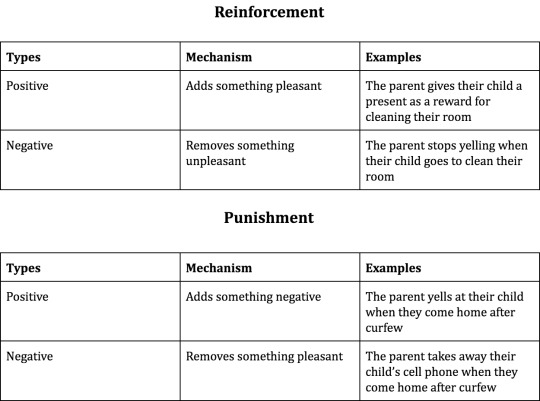
Punishment vs Reinforcement
Punishment is operant conditioning’s aversive conditioning. It is most effective if it is delivered immediately after the undesired behaviour. Harsh punishments can have unintended consequences, for example hitting your dog may dissuade it from misbehaving, but may cause fear or anger in the dog.
To get the rat to pull the lever in the box, Skinner used a process known as shaping. Shaping reinforces the steps used to arrive at the desired behaviour. If you’ve ever trained a dog, you’ll know that training requires incremental steps towards the behaviour, instead of immediately expecting them to do it. By rewarding approximations of the behaviour, it increases the chances they will stumble upon it later. Animals can also be taught to perform a number of responses successively. This concept is known as chaining.
Vocabulary used for classical conditioning also works with operant conditioning. Here they are with the context of a rat in a skinner box.
Acquisition: The rat learns to press the lever to get food
Extinction: The rat stops pressing the lever as it no longer gets food
Spontaneous Recovery: After extinguishing the original behaviour, without further training, the rat begins to press the bar again.
Generalisation: If the rat presses things like buttons, not just levers to get food
Discrimination: If the rat is only taught to press a specific bar, or only to press the bar when a sound is playing (in this scenario, the tone is a discriminative stimulus.)
There are two kinds of reinforcers. Primary reinforcers are naturally rewarding. Things like food, water, and rest that we don’t need to learn to enjoy. Secondary reinforcers are things we have learnt to value, such as praise or allowing someone to play a video game. Money is a generalised reinforcer, as it can be traded for virtually anything. An application of generalised reinforcers is called the token economy, where every time a person in a token economy performs something desired, they receive a token that they can trade for one of a variety of reinforcers. Not all reinforcers are desirable, and they’re not desirable all the time. Try rewarding a teen who’s just stuffed their face with cake, with even more cake and see how willing they are to win it. The idea that the reinforcing properties of something depend on the situation connects with the Premack principle, where whichever of the two activities is preferred can be used to encourage the less preferred activity.
Reinforcement Schedules
When behaviour has just begun to be learnt, continuous reinforcement is best, however, once it has been learnt, a partial reinforcement schedule tends to be ideal. According to the partial-reinforcement effect, behaviours are more resistant to extinction if the animal hasn’t been reinforcement hasn’t been done continuously. The types of partial-reinforcement are described in the table below.

Noticing a break in a variable pattern is much more difficult, which is why variable patterns are more resistant to extinction.
Biology and Operant Conditioning
As cool as operant conditioning is, it has its limits. Animals will not perform certain behaviours that go against their natural inclinations, for example, rats will not walk backwards. The tendency for animals to ignore rewards to pursue their typical behavioural patterns is called instinctive drift.
Cognitive Learning
The Contingency Model
The Pavlovian model of classical conditioning is known as the contiguity model as it states that the more times two things are paired, the greater the learning that will take place. Robert Rescorla’s research revised the Pavlovian model to apply it to more complicated scenarios.
In his experiments, he had two dogs, both of which were presented with food and a bell 10 times. However, one of the other dogs was also presented with 5 trials where the food was given with no bell, and 5 trials where the bell was rung with no food. Common sense says the first dog would have a stronger response, but the contiguity model says that their responses would be the same.
In comes Rescorla’s revision; the contingency model. This model states that A is contingent upon B when A depends on B and vice versa. In other words, the presence of one event reliably predicts the presence of the other. For the first dog, the food is contingent upon the presence of the bell, however, for the second one, the relationship between the US and the CS is less clear, making the following response less strong.
Observational Learning
As children grow up, they learn how to behave based on how the people in their lives do. This is known as observational learning, or modelling, and was studied extensively by Albert Bandura while he was forming his social-learning theory.
Modelling has two basic components: observation and imitation. In a scenario with two brothers, while the older brother is playing football outside, the little brother watches his little brother, and imitates his behaviour, playing football as well. However, modelling isn’t all positive. Children who grow up in abusive environments are more likely to model that behaviour when they grow up, leading to a cycle of behaviour.
Latent Learning
Edward Tolman did substantial research into latent learning. Latent learning is learning that only becomes obvious when reinforcement is given for learning it.
In his experiments, Tolman had 3 groups of rats go through a maze. One group was rewarded every time they finished the maze. Their performance in the maze improved rapidly. The second group was never rewarded and showed gradual improvement. The third group wasn’t rewarded for the first half of the trials, but for the second half received a reward. In the first half, their performance matched with the second group, however in the second half of the trials, their performance spiked, showing that the rats had learnt their way around the maze in the first half of the trials, however, their performance didn’t drastically improve because they weren’t motivated to improve.
Abstract Learning
Abstract learning is the idea that we learn in general, not necessarily about specific behaviours. Some animals used in skinner boxes like pigeons and rats have shown this ability. Pigeons, for example, have learnt to peck pictures that had never seen before if those pictures were of chairs.
Insight Learning
Wolfgang Kohler performed insight learning experiments on chimpanzees. Insight learning occurs when someone suddenly realises how to do a problem. A moment of insight can happen when you’re taking a test when all of a sudden you realise what the answer is. Kohler argued that learning happened in this sudden fashion because of insight and not because of the gradual strengthening of S-R connections.
In his study with chimpanzees, he put them into scenarios to see how they’d solve problems. In one, he suspended a banana from the ceiling, out of the chimps reach. He found that the chimps would spend most of their time unproductively using their time rather than gradually working towards the banana. All of a sudden, they would have a moment of insight, and stack boxes to reach it.

#psychology#AP psychology#psych#psychology studyblr#studyblr#study blog#psychology study blog#psych studyblr#psych study blog#biology studyblr#bio studyblr#biology study blog#bio study blog#biology#science#behaviorism#animal behavior#behaviour#animal behaviour#behaviourism#learning#abstract#pavlov#ivan pavlov
190 notes
·
View notes
Text
States of Consciousness
Consciousness is a concept that has eluded many psychologists and fascinated many others. The author of the first psychology textbook, William James was fascinated by this concept, however without the technology, we have today to examine it, the scientific study of consciousness faded away. It is coming back, due to new tools that can be used to study it in a scientific way, rather than a philosophical one. Historically, the idea of consciousness came from two competing philosophical theories; dualism and monism. Dualists believe that humans consist of two materials; thought and matter. Matter is everything in the physical world, while thought is a nonmaterial thing that arises from and is independent from the brain. Monists believe that thought and matter are made from the same material. The study of consciousness has progressed passed philosophy, however.
Levels of Consciousness
We experience consciousness unconsciously (try and wrap your mind around that). One level of your consciousness is reading this sentence, and another level is shaking your leg, or making you breathe. Research has begun to show more complex effects of the different consciousness levels. For example, the mere-exposure effect occurs when we prefer stimuli we have seen before over novel stimuli, even if we don’t remember seeing that old stimulus. One study investigating this phenomenon had participants look at a list of nonsense words for a short period of time, and then later on having them pick their favourite words from a new list. The participants were more likely to pick words shown on that earlier list, despite not being able to recall that earlier list. A concept related to this is priming. Priming is a technique where exposure to one stimulus influences a response to a subsequent stimulus without conscious guidance or intention. Another interesting phenomenon is blind sight. Some blind people have been shown to be able to describe the path of an object or grasp objects that they cannot see, implying that although their consciousness isn’t receiving visual information, another part of their consciousness can “see.” The levels of consciousness are very widely debated, but there is a tentative list of those layers.
Conscious Level: The information about yourself and your environment that you are currently aware of. You are consciously reading this sentence, for example.
Non-conscious Level: Body processes we usually are not aware of. This includes your heartbeat, respiration, digestion, etc.
Pre-conscious Level: Information about yourself and your environment that is not in your conscious mind presently, but has the potential to be. For example, you’re not thinking about your last maths class right now, as that memory is at your preconscious level, but by reading that sentence, a memory may come to your conscious level.
Subconscious Level: Information we are not consciously aware of that informs and is shown through our behaviour. Priming and the mere-exposure effect reveal this layer of consciousness.
Unconscious Level: This is a level of consciousness studied by psychoanalysts. Psychoanalysts believe that memories and feelings deemed as inappropriate by the conscious mind are repressed into the unconscious mind, and can be uncovered by methods such as dream analysis. This is a very widely objected idea, however, as it is extremely difficult, if not impossible to prove.
Sleep
Sleep is something many students never get enough of. According to surveys, high school students get around 6.8 hours of sleep per night, and college students get between 6 to 6.9 hours per night, despite a need for 8-9 hours. But why do we need sleep? And how does it work?
The Sleep Cycle
If you’ve ever been jet-lagged, you know how it feels to have an issue with your circadian rhythm. The circadian rhythm is a 24-hour cycle that instructs our metabolic and thought processes. It makes us feel hungry at lunchtime, need the toilet when we usually go and makes us feel tired at bedtime. It also controls the sleep cycle. Sleep is not an 8 hour period of time where the brain nearly completely shuts down, in fact, our brains are active as we sleep, and can be tracked with an EEG, revealing distinct stages as sleep occurs.

The period where we are falling asleep is known as sleep onset. It’s the period where we are not yet asleep, but not quite awake. When we are awake and sleepy, our brains produce alpha waves- this is a period where we may experience mild hallucinations before we enter stage 1 of sleep. When awake, and when in stages 1 and 2, our brains produce theta waves, which are high in frequency and low in amplitude. They progressively slow down and rise in amplitude as stages 1 and 2 progress. In stage 2, EEG’s show sleep spindles, which are short bursts of rapid brain waves. From stage 2, we move into stage 3 and stage 4, which are known as delta sleep. After the delta waves produced in this period of sleep. These are slow, low frequency waves, and characterise the deepest sleep, and the period where we are least aware of our environment. Being awakened from stages 3 and 4 tend to cause intense drowsiness, and disorientation and is often why being woken up with an alarm clock can suck, even after getting 8 hours of sleep. After going through delta sleep, brain waves begin to speed up again and we go back through stages 3 and then 2. Before getting back to stage 1, the brain enters a period of intense activity, where the eyes rapidly move back and fourth, and muscles twitch rapidly. This is known as REM, or rapid eye movement sleep. It’s also known as paradoxical sleep because brain waves are as active as if we were awake. Dreams are most likely to occur here, and depriving the body of it can interfere with memory. After being deprived of REM sleep, individuals typically experience REM rebound, where they have longer and more periods of REM sleep the next time they sleep. The cycle is not consistent, as you can see on the chart. As wake up time moves closer, the body spends more time in stages 1 and 2, along with REM. Babies spend more time in REM than adults do, and as we age, we need less sleep, and spend less time in REM.
Sleep Disorders
Poor, or inconsistent sleep can cause serious health issues. While for many people, poor sleep is a result of lifestyle choices, or poor decisions, many people suffer from disorders which even in the perfect environment for sleep, cause issues fully moving through the sleep cycle.
Insomnia: Insomnia is the most common sleep disorder, affecting up to 10% of the American population. Insomniacs struggle with going to sleep, and staying asleep. Treatments for insomnia include changes in behaviour, such as decreasing caffeine-intake and other stimulants, exercising at appropriate times during the day, and keeping a consistent sleep pattern going (always going to bed at 10pm and waking up at 6am, for example.) Many doctors are cautious about prescribing pills because pills can actually interfere further with the sleep cycle.
Narcolepsy: Narcolepsy is far more infrequent than insomnia, affecting about 0.001% of the American population. Narcoleptics experience periods of intense drowsiness, and fall asleep at inappropriate and random times. Medication, and behaviour change are often prescribed to help combat it, for example naps at strategic times.
Sleep Apnea: Sleep apnea is almost as common as insomnia, and in many ways is more serious. Sleep apnea is a condition where people stop breathing for short periods during sleep. The body slightly wakes the person up to gasp for air, then puts them back to sleep. This robs the individual of deep sleep and can cause disorientation, memory issues and attention issues. Severe apnea has been known to kill people. It is especially common in overweight men. Respiration machines can help combat this disorder.
Night terrors: Many people (myself included) remember having nightmares when they were young. Being a typical British child, I watched doctor who, and remember in the middle of the night running up to my parents room, terrified the Cybermen from my dreams were going to get me. They typically go away as the person gets older, but many adults, especially those suffering from conditions such as PTSD continue to suffer from them, causing severe sleep deprivation.
Somnambulism: Somnambulism is a fancy way of saying sleepwalking. It is much like nightmares, in that both commonly occur in the first few hours of sleep, at the fourth stage. Somnambulism is also much more common in children, and tends to go away as the person grows up.
Dreams
Dreams are a series of story-like images we tend to experience when we’re asleep. Some people frequently recall their dreams, while others don’t remember dreaming at all. Some people have lucid dreams, where they know they’re dreaming, and can control its storyline. They are difficult to study, as we don’t know much about them, so as a result, psychologists depend mostly on self-reports. When patients are woken from REM sleep, they often report dreaming. There are many hypotheses about why we dream, but not many conclusive answers yet. Sigmund Freud found dreams to be a significant part of his therapy. His therapy used dream interpretation to uncover repressed information in the unconscious mind. Manifest content is the literal content of the dream. If someone dreams about showing up unprepared to a test, the manifest content is the ill-preparedness. The latent content is what Freud was more interested in; it is the unconscious meaning of that manifest content. Freud believed that even in sleep, the ego shields us from unconscious material (thus he referred to it as protected sleep). Showing up ill-prepared for a test could represent anxiety and preparedness about a coming challenge in your life, for example. Many researchers dislike this research because it is extremely difficult to validate or invalidate. The activation-synthesis theory observes dreams as a biological phenomenon. This theory suggests that dreams are merely the brains interpretation of what is happening physiologically during REM sleep. This implies that dreams are no more significant as any other physiological process. The information-processing theory falls in between these two theories. It points out that stress can increase the number and intensity of dreams during the night, and many report that dreams address many daily concerns. Some people theorise that the brain is dealing with daily stress and information during REM sleep. REM is thus a process where information taken in during the day is processed into our memories.
Hypnosis
One of the more popularised forms of psychology is hypnosis. There are films all over the place of nightmarish villains putting a watch in front of an unsuspecting victims face, and taking over their mind, making them do whatever the hypnotist wants. While this is not real, hypnosis is a real phenomenon used by many hypnotherapists to help their patients deal with real world problems, or to have a bit of fun. One phenomenon observed under hypnosis is posthypnotic amnesia. Where patients report forgetting events that occurred while they were hypnotised. Hypnotists can also implant posthypnotic suggestions, where the patient behaves a certain way after coming out of hypnosis. It’s important to note that hypnosis patients are not unconscious, and cannot be made to do things that consciously they absolutely do not want to do, or cannot do. Hypnosis, like all other parts of consciousness is not very well understood. There are 3 big theories which attempt to explain what is happening during hypnosis.
Role theory: States that hypnosis is not an alternate state of consciousness at all. Some people are more easily hypnotised than others, a phenomenon known as hypnotic suggestibility, and these patients share many other characteristics such as having richer fantasy lives, being better at following directions, and being more able to focus on tasks for longer periods of time. This imply that hypnosis is a social phenomenon, where patients act out the role of a hypnotised person because that is what is expected of them.
State theory: States that hypnosis in some ways meets the definition for an altered state of consciousness. Hypnotists can suggest more or less awareness of the environment, and many who undergo hypnosis report dramatic health benefits such as pain control.
Dissociation theory: This is a theory stated by researcher Ernest Hilgard, and claims that hypnosis causes a voluntary division of consciousness. One part responds to the hypnotic suggestions, and the other retains awareness of reality. In his experiments, Hilgard had hypnosis patients out their arm into an ice water bath. Although this would normally cause pain, his patients reported none. However, Hilgard had these patients lift their index finger if any part of them felt pain, and most participants lifted their finger.
Drugs
Psychoactive drugs change the chemistry of the brain and induce an altered state of consciousness. Some of these changes are physiological changes, while others are caused by expected changes. Some patients exhibit some of the expected effects of the drug, even if they didn’t ingest the drug (similar to the placebo effect.) Normally, the brain is protected from harmful substances in the blood via the blood-brain barrier. However, the molecules which make up psychoactive drugs can pass through this barrier as they are small enough. They either mimic natural neurotransmitters- these are known as agonists. Agonists fit into receptor sites on neurons which would normally receive the neurotransmitter. They can also block neurotransmitters- these psychoactive drugs are known as antagonists. These molecules also fit into receptor sites, however prevent neurotransmitters from the receptor site. Other drugs can prevent neurotransmitters from being reabsorbed, creating an abundance in the synapse. This is what Prozac, an depressant does. It is called a “selective serotonin reuptake inhibitor” as it prevents serotonin from being reabsorbed.

In some cases, due to the abundance of psychoactive drugs, the brain may produce less of the neurotransmitter, a phenomenon known as tolerance, where the patient needs more of the drug to produce the same effect. Tolerance eventually leads to withdrawal, which varies in intensity, from a headache to intense muscle spasms. Dependence can be physiological, psychological, or both. Psychological dependence creates an intense craving for the drug, while physiological dependence creates a need for the drug to prevent withdrawal symptoms. Researchers classify psychoactive drugs differently, however most place them in 4 categories.
Stimulants: Stimulants include caffeine, cocaine, amphetamines, and nicotine. Stimulants speed up body processes such as the autonomic nervous system functions- (heart rate and respiration rate etc). This commonly comes with a sense of euphoria. Side effects can include disturbed sleep, reduced appetite, increased anxiety, and heart problems, depending on the power of the drug.
Depressants: Depressants include alcohol, barbiturates, and anxiolytics (tranquilisers/anti-anxiety medication- Valium, for example). Alcohol is the most commonly used psychoactive drug. It slows down the body systems that stimulants speed up. Although drinkers typically report a feeling of excitement, this can be a result of expectations, and the depression of the part of the brain influencing inhibitions. They can slow down reaction times and judgement, which is why drinking while driving is so dangerous. Enough alcohol can impact the cerebellum, severely reducing motor control.
Hallucinogens: Hallucinogens, or psychedelics are drugs which don’t speed the body up or slow the body down. Instead, they cause changes in the perception of reality. Common psychedelics include LSD, peyote, psilocybin mushrooms, and marijuana. Hallucinogens can stay in the body for weeks, and ingesting more of it during this period compounds the lingering amount, causing more profound and dangerous effects. This is known as reverse tolerance, because even if the second dose is less, the effects are greater.
Opiates: Opiates include morphine, heroine, methadone, and codeine, and are extremely dangerous. In the United States, they are severely overprescribed which has caused a national health crisis, where in 2017, over 70,000 people died from overdose, making it a leading cause of injury-related death in the US. They are agonists for endorphins, making them extremely powerful painkillers and mood elevators. They cause drowsiness and euphoria. They are some of the most physically addictive drugs as they rapidly create tolerance, and cause some of the most extreme withdrawal symptoms.
#sleep#sleep studies#sleep research#consciousness#psychoanalysis#studyblr#study blog#psychology#cognitive psychology#psychology studyblr#biology studyblr#psychology study blog#biology study blog#science#research#drugs#hypnosis#circadian rhythm
265 notes
·
View notes
Note
What do chromosomes actually do???
Basically, they’re clumps of genetic material. Each chromosome contains a certain number of genes. Genes are stretches of DNA which contain the instructions for certain proteins. RNA polymerase will bind to a gene, produce mRNA, and begin the process for making that protein. We classify and draw chromosomes based on their extremely condensed state when a cell is dividing because it’s easiest to see them that way (Otherwise we’d be studying squiggles which is much less satisfying to draw)
#biology#biology studyblr#microbiology#genetics#classical genetics#molecular genetics#studyblr#study blog#biology study blog#genetics studyblr
8 notes
·
View notes
Text
Sensation and Perception
For us to sense the world around us, our sensory organs receive stimuli. The messages those organs produce go through a process known as transduction. This means that the signals are transformed into impulses that travel through the thalamus to the appropriate cortices. Our bodies are constantly sending signals to the brain, but if it were to register every sensation, it would be overwhelming. Imagine feeling, seeing, hearing, touching, etc.. everything. This doesn’t happen due to the combination of sensory adaptation (the decrease in responsiveness to stimuli due to constant stimulation) and sensory habituation (our perception of sensation is partially due to how focused we are on them.) Now that I mention it, you likely will start to feel the socks on your feet, even though you hadn’t noticed that before, as you weren’t focused on the sensation. This connects to the cocktail-party phenomenon which is the idea that as your focus changes, you ignore certain stimuli, for example, at a party, if you’re focused on your friend talking, and someone yells your name across the room, your focus may involuntarily shift to whoever is yelling at you, causing you not to hear what your friend is saying.
ENERGY SENSES
Vision
Step 1: Gathering Light: Light reflects off of surfaces and hits our eyes. The colour we perceive that surface to depend on a few things; one, the light intensity which is to say, how much energy is in the light that hits the eye. The second is the light wavelength, which determines the hue that we see. (Or if we even see it at all- wavelengths longer than visible light such as infrared waves, microwaves and radio waves or shorter than visible light such as UV waves and X-rays aren’t registered by the eye) A mix of all the visible hues of light produces white. When an object appears a certain colour, it has absorbed all other colours and reflected the colour we see it as. A green plant, for example, would not be able to survive in the green light, as it would reflect the green, causing it to starve.
Step 2: Within the Eye: Reflected light enters the eye through the cornea which is a clear protective covering over the eye. The light travels through a hole known as the pupil. The iris (what make your eyes a certain colour) is a collection of muscles which work to constrict the pupil in extremely light situations, and expand the pupil in dark places- this is known as accommodation. The curved lens focuses the light like a camera focuses on an image. The image is flipped upside down as it travels through the lens. This now focused, inverted image project itself on the retina which works as a screen. On this screen are specialised neurons which are activated by light.
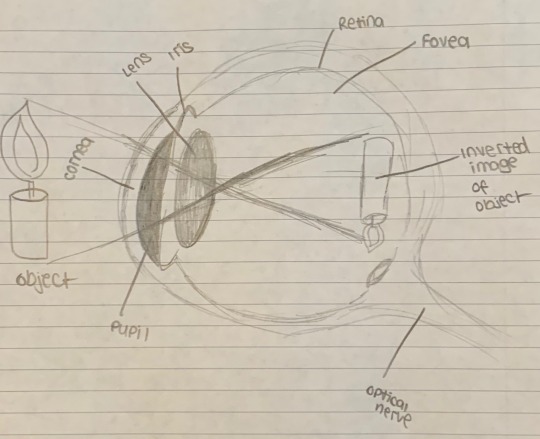
Step 3: Transduction: The light needs to be translated into neural impulses to be registered by the brain. There are two kinds of neurons which do that job. Cones, which are activated by colour and rods, which respond to black and white. Rods outnumber cones, and are especially useful in dark situations when colour cannot be registered at all; this is why in the dark, it is nearly impossible to figure out what colour an object is. There just isn’t enough coloured light being reflected for the cones to be activated properly. Cones are concentrated in the centre of the retina. At the very centre of the retina is the fovea; where the highest concentration of cones exists. Peripheral vision depends on cones, while your centred of vision depends on cones (in light, of course). Once enough rods and cones fire, they activate the next layer of bipolar cells; ganglion cells, whose axons make up the optic nerve, sending impulses to the lateral geniculate nucleus (LGN) of the thalamus. Messages are relayed to the visual cortex in the occipital lobes. The optic nerve has no rods or cones and is known as your blind spot (different to the driving blind spot). There are two parts to the optic nerve. Impulses from the right side of both retinas go to the right hemisphere, while impulses from the left side of both retinas go to the left hemisphere; it is that separation of the optic nerve that allows this to take place. The spot where the optic nerves cross each other is the optic chiasm.
Here’s a fun experiment to show where the blind spot is. (Here is the original link for anyone curious: https://visionaryeyecare.wordpress.com/2008/08/04/eye-test-find-your-blind-spot-in-each-eye/- it has a few more interesting experiments to try as well)

Sit with your nose between the cross and black circle. Cover your left eye, and look at the cross with your right eye. Move towards the computer while still using your right eye. Eventually, the black circle will disappear and reappear, showing you your blind spot. Do the same with your left eye, except now focus on the black circle. Weird right?? (Science rules!)
Step 4: In the Brain: There is still a lot of debate as to how our visual cortex actually works to register vision. Some say the visual cortex is where sensation ends and perception begins. Some say interpretation begins at the retina. Some say it begins at the thalamus. Scientists David Hubel and Torsten Wiesel were responsible for finding that groups of neurons in the visual cortex respond to different types of visual images. There are feature detectors for vertical lines, curves, motion, and so on.
Theories of Colour Vision
A lot is still unknown about how we see colour. The oldest theory is the Young-Helmholtz Trichromatic theory which hypothesised that we have 3 different typed of cones which detect, red, blue and green. They are activated in different combinations to produce the spectrum of colour we see. There are issues with this theory; namely afterimages and colour blindness. That’s where the opponent-process theory of colour vision comes in. (Not to be confused with the opponent-process theory of emotion. I’ll get to that in a later post). This theory states that sensory receptors are arranged in pairs: red/green, yellow/blue, and black/white. When one sensor is stimulated, its pair is inhibited. This explains after images. Try this illusion out: Stare at this image for 30 seconds, and then look at a white surface. If the flag doesn’t immediately show up try blinking a few times.

What’s happening is that you’ve exhausted your cones, and so the opponents will fire. This is why dichromatic colour blindness also tends to be consistent as to which two colours are affected such as red-green colour blindness, or yellow-blue colour blindness
Hearing
While both vision and hearing are considered energy senses, they are very different stimuli. Sound waves are vibrations in the air, instead of electromagnetic waves used to produce images. The vibrations are captured by our ears and transduced into neural impulses which allow the brain to register and interpret the sound. Sound waves have amplitude and frequency. Amplitude is the height of the wave and determines how loud the sound will be. Frequency is the length of the waves and determines the pitch of the sound. High-frequency waves are densely packed together, while low-frequency waves are spaced apart.
The process of hearing works much like a Rube Goldberg machine, where one thing moving activates the next part of the sequence. The pinna (outer ear) collects sound, which travels down the auditory canal. The sound reaches the tympanic membrane (the eardrum) which vibrates as sound hits it. Attached to the tympanic membrane are the ossicles; the smallest bones in your body. The tympanic membrane is connected to the hammer/malleus, which is connected to the anvil/incus, which is connected to the stirrup/stapes, which all transmit the vibration to the oval window, a similar membrane to the eardrum. The windows membrane is connected to the cochlea, a snail-like structure filled with perilymph, and endolymph. The vibration of the oval window causes these fluids to move. At the base of the cochlea is the basilar membrane, lined with hair cells connected to the Organ of Corti, which are neurons activated by the moving hair cells. The Organ of Corti fires neural impulses and those impulses travel to the brain via the auditory nerve.
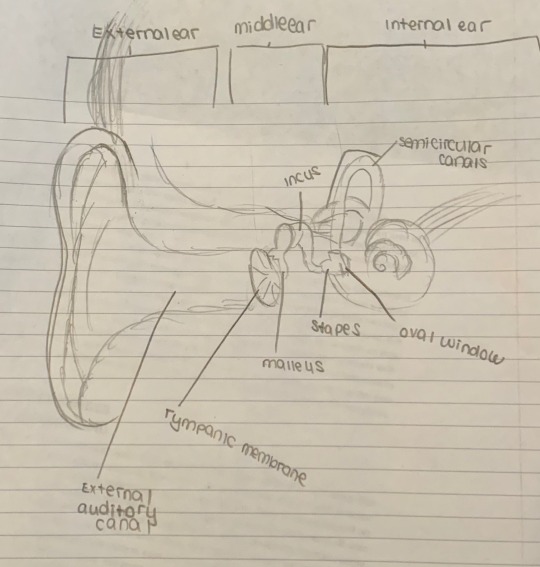
Pitch Theories
Place Theory: Place theory states that hair cells in the cochlea respond to different frequencies based on their location. Some bend to high pitches, and others to low pitches.
Frequency Theory: Research has shown that while place theory is accurate for high pitches, but not for low tones, who are sensed by the rate at which the cells fire. We sense pitch because hair cells fire at different rates (frequencies) in the cochlea.
Deafness
For each step in the hearing process, there are just as many ways those steps can go wrong. Conduction deafness refers to a problem conducting sound to the cochlea (so any point in the ear canal, to the eardrum, ossicles, or oval window). Sensorineural deafness occurs when the hair cells in the cochlea are damaged. Often this is caused by overstimulation, causing a high pitched ringing. Prolonged exposure to that much stimulation can severely damage the hair cells which do not regenerate.
Touch
There is one more type of energy sense and it is just as different as the other two. Our skin contains millions of different types of receptors. Some (nociceptors) respond to pain, some (thermoreceptors) respond to temperature. Some (Messiner’s Corpuscles) respond to plain old touch. Some (Pacinian Corpuscles) respond to pressure, all of which can be found all over the skin. The relationship between these receptors is not well understood. What we do know is that the brain interprets the amount of indentation (temperature change) and the intensity of touch. Where nerve endings fire also determines where the touch is coming from. Certain parts of our body have more concentrated amounts of receptors.
For example, in my physiology class, we did an interesting experiment where a friend took a paper clip and unfolded it until it had 2 ends. The friend would poke me on different parts of my skin with either 1 or 2 of the ends and see if I could guess how many ends I was being poked with. On the fingertip, I guessed with 100% accuracy, while on my shoulder, I was guessing the whole time.
Gate-control theory explains how pain is experienced. Some pain messages are more important than others. When a priority message is sent, the “gate” swings open for it and swings shut for lower priority messages. This is why scratching an itch gets rid of the itch. The scratching is a higher priority message, and so the itch is temporarily ignored in order to prioritise the itching. That’s also why you shouldn’t scratch an itch- you’re not doing yourself any good. Endorphins also work to shut this gate, working like morphine to shut off any pain.
CHEMICAL SENSES
Gustation/Taste
Fun fact before I start: I remember that taste is gestation because of Gusteau from Ratatouille who was named after the French word for taste. When you eat food, the tastebuds are not responding to energy, but rather the chemicals on the tongue. These tastebuds are located on papillae, which are bumps on the tongue. There are 5 different kinds of tastebuds scattered throughout the tongue which respond to Sweet, Salty, Bitter, and Umami (savoury). The more densely packed the taste buds, the more intense the taste is. The tongue is not unique to taste; you’ll know this if you’ve ever tried to eat a jalapeno because spicy food stimulates nociceptors, which is why the experience is agonising for some people. Weaker nociceptors increase a person’s spice tolerance, which is why certain cultures do better eating spicy foods; they’ve adapted to the pain.
Smell/Olfaction
Olfaction is created by chemicals entering the nose and being absorbed by receptors on the mucous membrane. A lot is not known about these receptor cells- some researchers estimate there are as many as 100 different types. These cells are linked to the olfactory bulb which gathers messages from olfactory receptor cells and relays them to the brain. The nerve fibres from the olfactory bulb connect to the brain differently than all the other senses; instead of going to the thalamus, the message is sent to the amygdala and then the hippocampus. This could be why smells can trigger memories much more strongly than other senses can.
BODY POSITION SENSES
Let's get something out of the way: you do not have 5 senses. How many you have depends on who you ask, but a prominent one is the sense of position.
Vestibular Sense
Your vestibular sense helps you determine where your body is in space. The semicircular canals in the inner ear are responsible for this. The canals are tubes partially filled endolymph. When the head moves, the fluid moves too. The hair cells activate, sending signals to the brain telling it that the head has moved. Dizziness is caused when the brain receives several conflicting signals in a short period of time, caused by rapid movement, or when you’re in a boat, and the eyes register a static view, while the inner ear is registering all kinds of movement.
Kinesthetic Sense
While vestibular sense tracks the overall orientation of the body, kinesthetic sense tracks the position and orientation of specific body parts. Receptors in muscles and joints send information to the brain, helping the brain track the body.
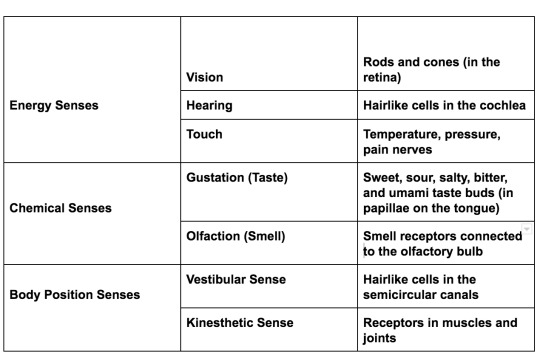
PERCEPTION
Perception is the process of understanding and interpreting sensations. Psychophysics is a branch of psychology which studies the interaction between sensations and how we experience them.
Thresholds
Senses have limits. The absolute threshold is the smallest amount of stimulus we can detect. There are several videos online helping people track the absolute threshold of pitch that they can detect by playing higher and higher frequencies. The proper definition of the absolute threshold is the minimal amount of stimulus we can detect 50% of the time as things such as other sensory inputs can make studying the absolute threshold extremely difficult. Stimuli below the absolute threshold are referred to as subliminal.
Another important threshold is the difference threshold. This is also referred to as the just-noticeable difference and is rather self-explanatory. It is the smallest amount of change in a stimulus needed for us to detect a change. This threshold is determined by Weber’s Law, discovered by psychophysicist Ernst Weber (it is sometimes called the Weber-Fechner law.) The change needed is proportional to the original intensity of the stimulus. The more intense a stimulus, the more it will need to change before we notice a difference. Each sense varies according to a constant (which differs between the senses). The constant for hearing is 5%- when listening to a 50-decibel tone, it would need to reach 52.5 decibels to notice a difference.
Perceptual Theories
Signal Detection Theory: This theory investigates the effects of distractions and interference we normally experience in our lives. This area of research revolves around attempting to predict what we will perceive. It takes into account how motivated we are to perceive specific stimuli and our expectation. These are known as response criteria or receiver operating characteristics. A false positive is when we think we are perceiving a non-present stimulus. While a false negative is the failure to perceive a present stimulus.
Top-Down Processing: When we use top-down processing, we perceive by filling in gaps what we sense. For example, when reading this sentence: I _m t_king p_ych_ _ gy, you can pretty easily fill in the blanks based on the context of what you read before, and the letters I did give you. In other words, top-down processing uses background knowledge to fill in gaps. Our schemata are mental representations of how we think the world should be. They can create a perceptual set or a predisposition to experience something a specific way. https://www.youtube.com/watch?v=Bafuyg98no4- Watch this video about backmasking (”hidden” messages in songs when played backwards.) Try looking away when the song starts playing and then reading the supposed message. I know personally, when I did this, I couldn’t understand the hidden message until I read what I was supposed to be hearing, and then I could hear it clearly. Several parents became worried about this phenomenon, likely because they had schemata of the music their kids were listening to as dangerous.
Bottom-Up Processing: This is also known as feature analysis, where only the features of the object are used to build a perception. This is an automatic process, however, is much slower than top-down processing. As a result, it is less prone to error.
Principles of Visual Perception
There are numerous rules for visual perception. One of the first decisions the brain makes is the figure-ground relationship. This is self-explanatory; what is the figure and what is the background? A famous illusion connected to this principle is the vase face illusion. Do you see the background as black or white? Do you see the figure as the vase or the face?

Gestalt Rules
Gestalt psychologists at the beginning of the twentieth century noted several principles which explain how we perceive groups of objects, and theorised that we perceive images as groups rather than individuals. (Hence the name “Gestalt”) Here is a great diagram from https://www.verywellmind.com/gestalt-laws-of-perceptual-organization-2795835 illustrating those principles.
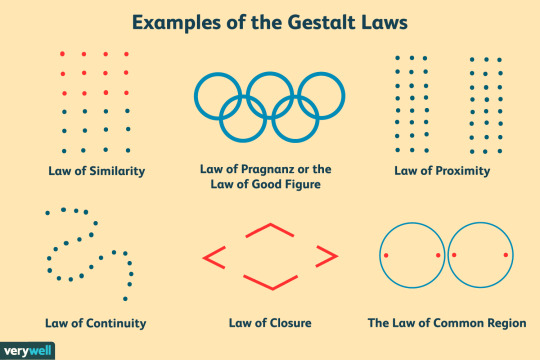
Proximity: Objects that are close together are more likely to be perceived as a part of the same group
Similarity: Objects that look similar to each other are likely to be perceived as part of one group
Continuity: Objects creating a continuous form are likely to be perceived as part of the same group
Closure: Similar to the sentence connected to top-down processing. Objects making a recognisable image are likely to be viewed as part of the same group
Law of Pragnanz: You are more likely to perceive and interpret complex images as the simplest form possible
Law of Common Region: Objects grouped together within the same region of space tend to be viewed as their own group.
Constancy
Our ability to maintain a constant perception of an object despite a constantly changing world is known as constancy. Here are a few types.
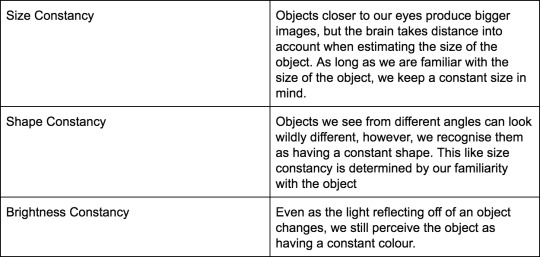
Perceived Motion
Our brains can detect how fast images move across the retinas and use our own motion to determine the speed the object is moving. This causes some interesting phenomena where the brain thinks a still object is moving. For example, you may be familiar with the stroboscopic effect. This is what causes perceived motion in flipbooks. There is also the phi phenomenon. Movie Marquees use this phenomenon by turning on and off lights sequentially, creating the appearance of one moving light.

Depth Cues
Depth perception is what allows us to perceive the world in 3-dimensions rather than 2. Eleanor Gibson performed an interesting experiment known as the visual cliff experiment, which found that crawling toddlers can perceive depth. In this experiment, the infant is placed onto one side of a glass table, creating the appearance of a cliff. The infant would not crawl onto the glass. There are two categories of cues that we use; monocular (needing one eye) and binocular (needing two)
Monocular Cues
Artists tend to use monocular cues to create the illusion of depth in their art. A wonderful artist on deviant art created a really helpful diagram, illustrating each of these ideas. https://www.deviantart.com/akenon/art/Monocular-Cues-34065283
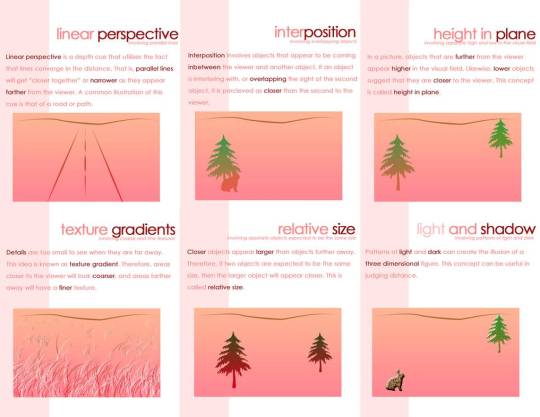
Linear Perspective- In order to draw a faraway house, artists tend to draw two lines which converge at a focal point, taking advantage of the linear perspective cue.
Relative Size Cue- When drawing two similarly sized cats, one far away and one nearby, an artist will draw the faraway cat as significantly smaller, creating the illusion of distance.
Interposition Cue- If the artist draws a cat that is partially obscured by a tree, we will view the tree as closer than the cat.
Texture Gradient- Another way artists create the illusion of distance is by making close up objects more detailed than those faraway
Shadowing- By using shading in an image, an artist can imply a light source, further implying depth in the image.
Binocular Cues
Binocular Disparity/Retinal Disparity- Each eye sees an object at a slightly different angle. The farther away an object is, the more similarly the eyes will perceive it, the closer it is, the more retinal disparity there will be. Notice in this diagram how the trees don’t seem to move, but the finger moves drastically?
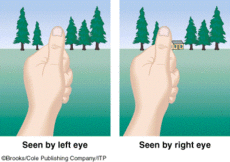
Convergence- As an object comes closer to our face, the eyes must move towards each other to keep it in focus. The more the eyes converge, the closet the object is.
How Culture Affects Perception
One of the more interesting (in my opinion) parts of psychology is exploring how culture affects us. Some of the perceptual rules that for years psychologists believed to be innate are actually learnt. Cultures which don’t use monocular depth cues in their art don’t see depth in pictures using these cues. It also affects how optical illusions affect our brains. The famous Muller-Lyer illusion often does not affect cultures that don’t use right angles and corners in architecture.

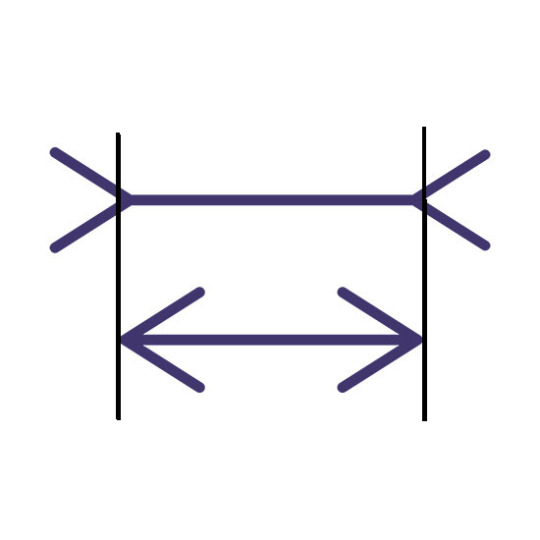
#AP Psych#AP Psychology#psychology studyblr#psych studyblr#human anatomy studyblr#physics#psychophysics#physiology studyblr#sensation#perception#eye anatomy#ear anatomy#anatomy#human anatomy#biology#biology studyblr#studyblr#bio#human bio#human biology#physio#human physio#human physiology
29 notes
·
View notes